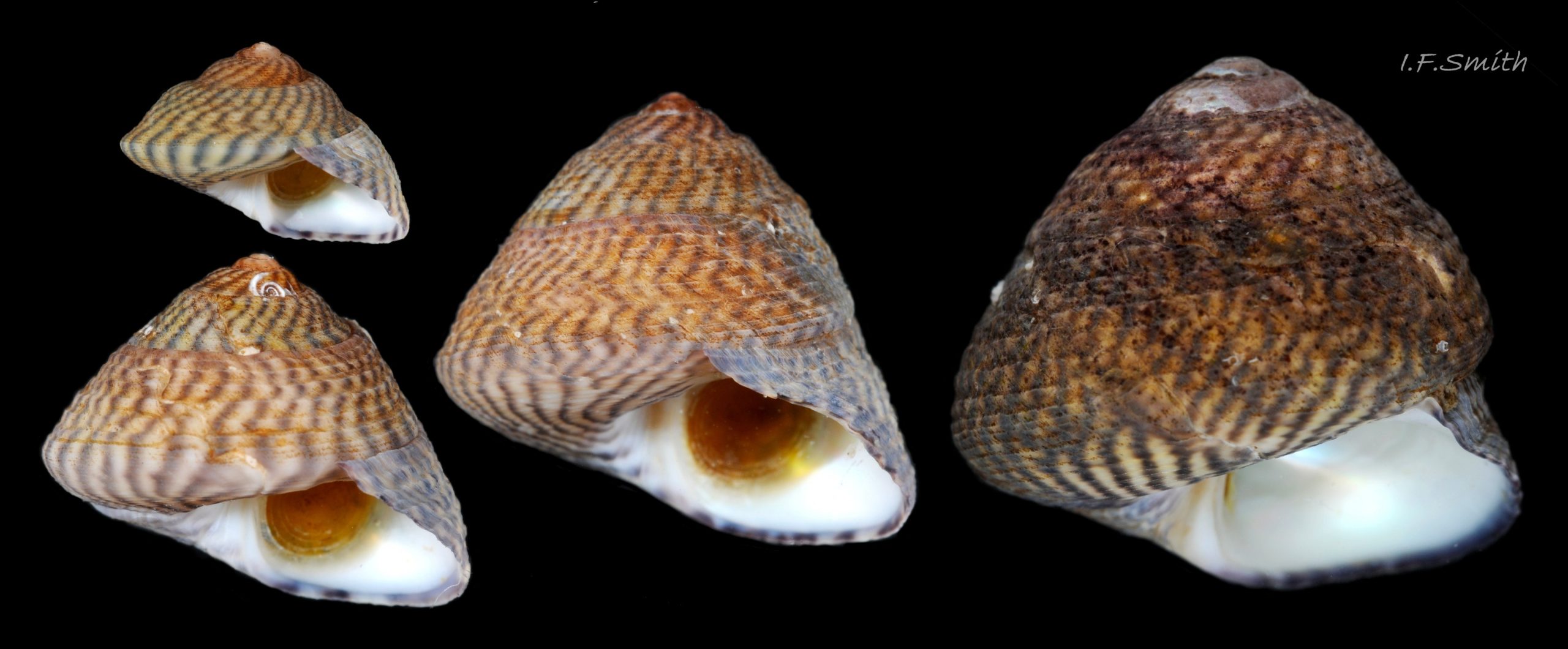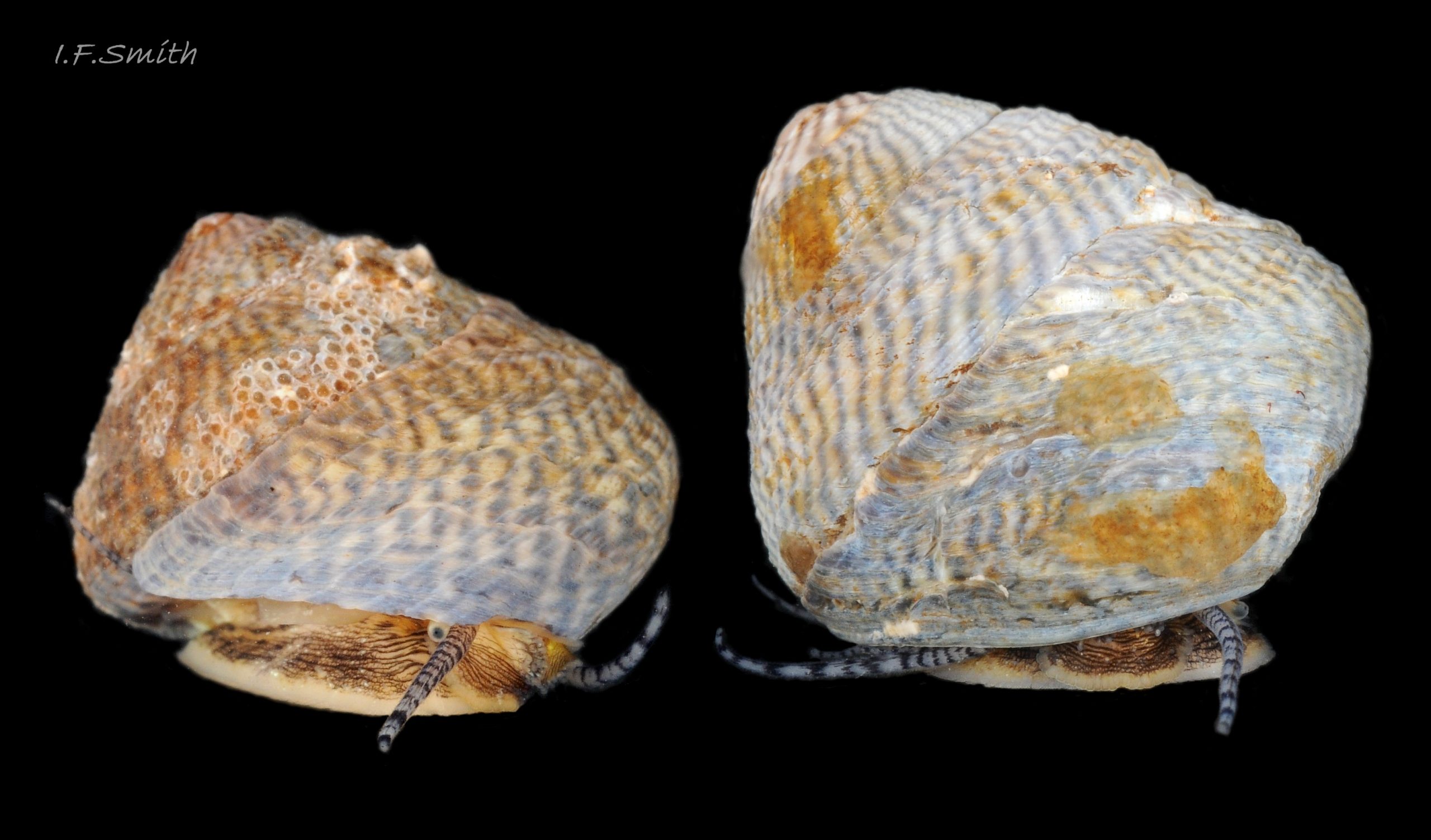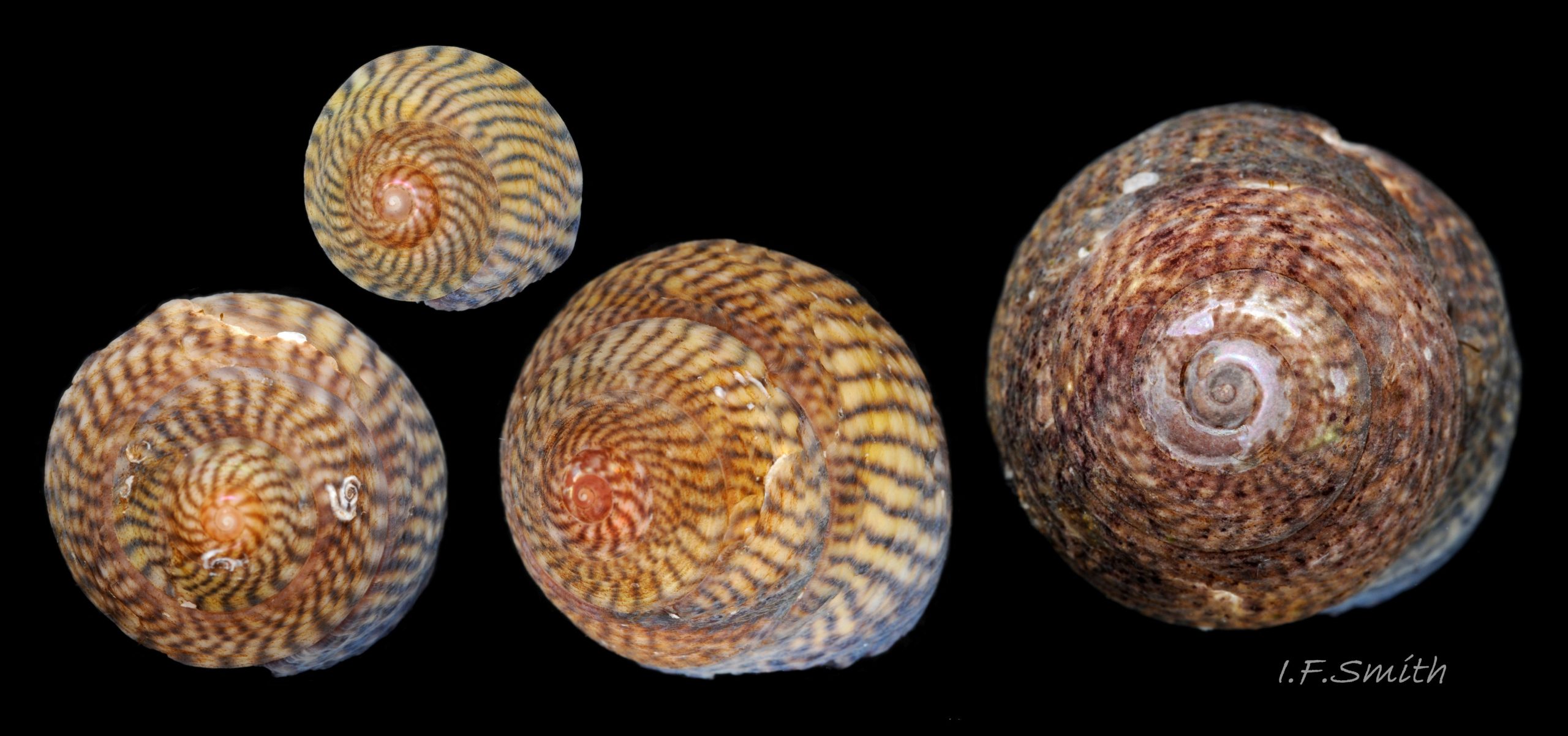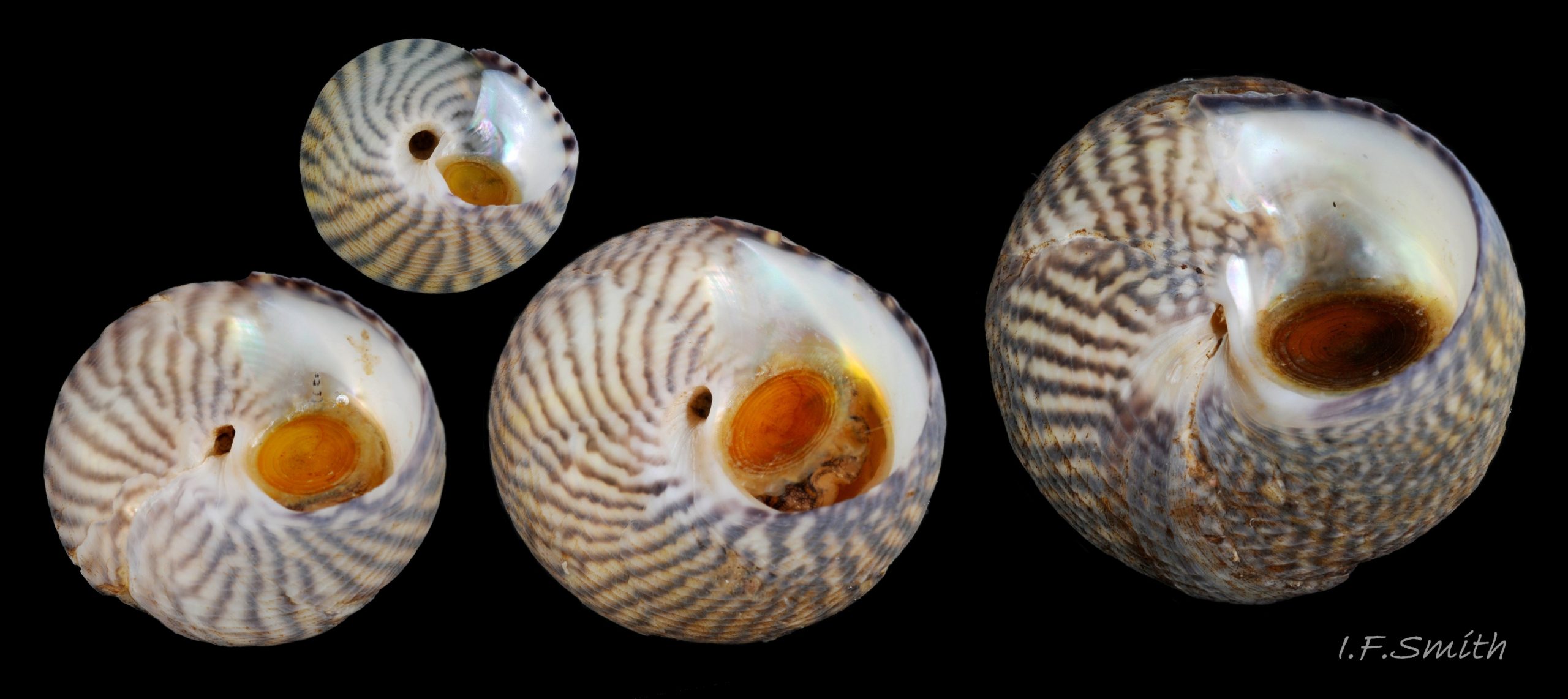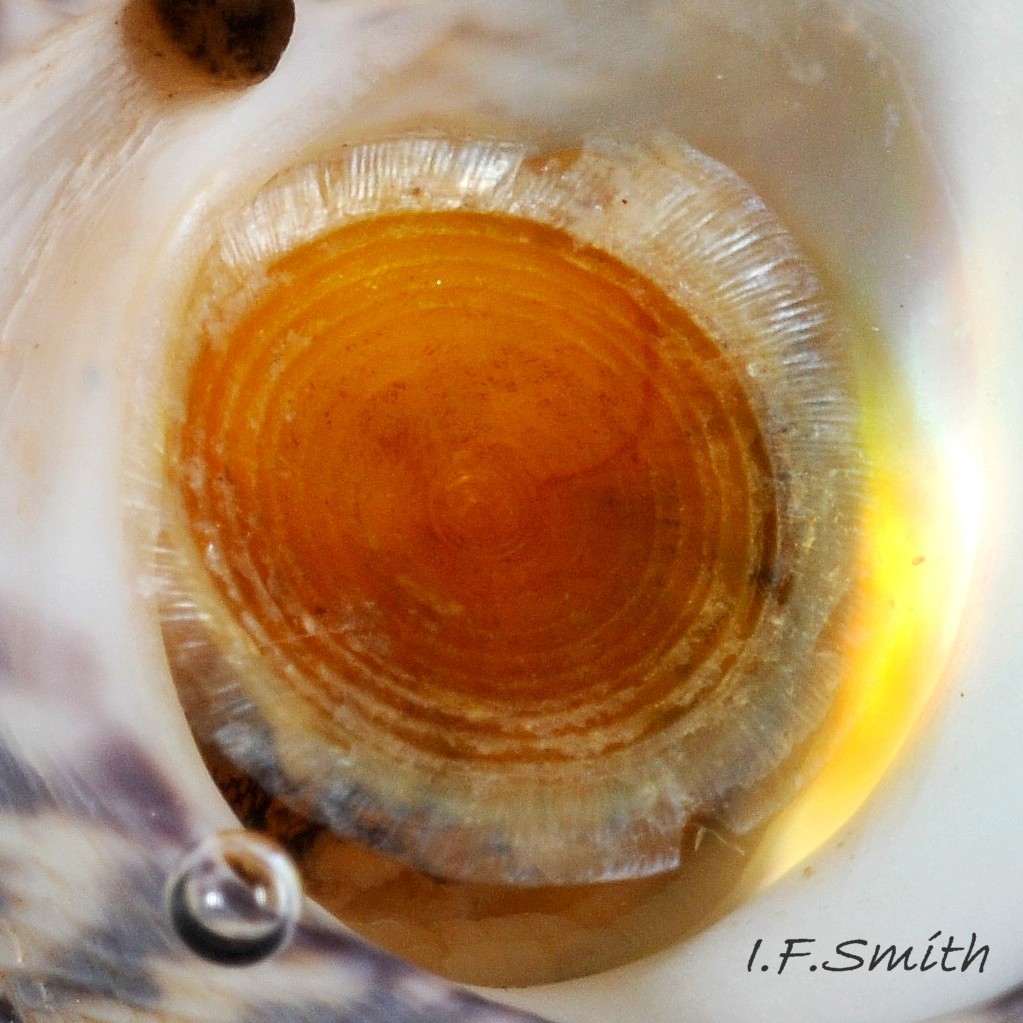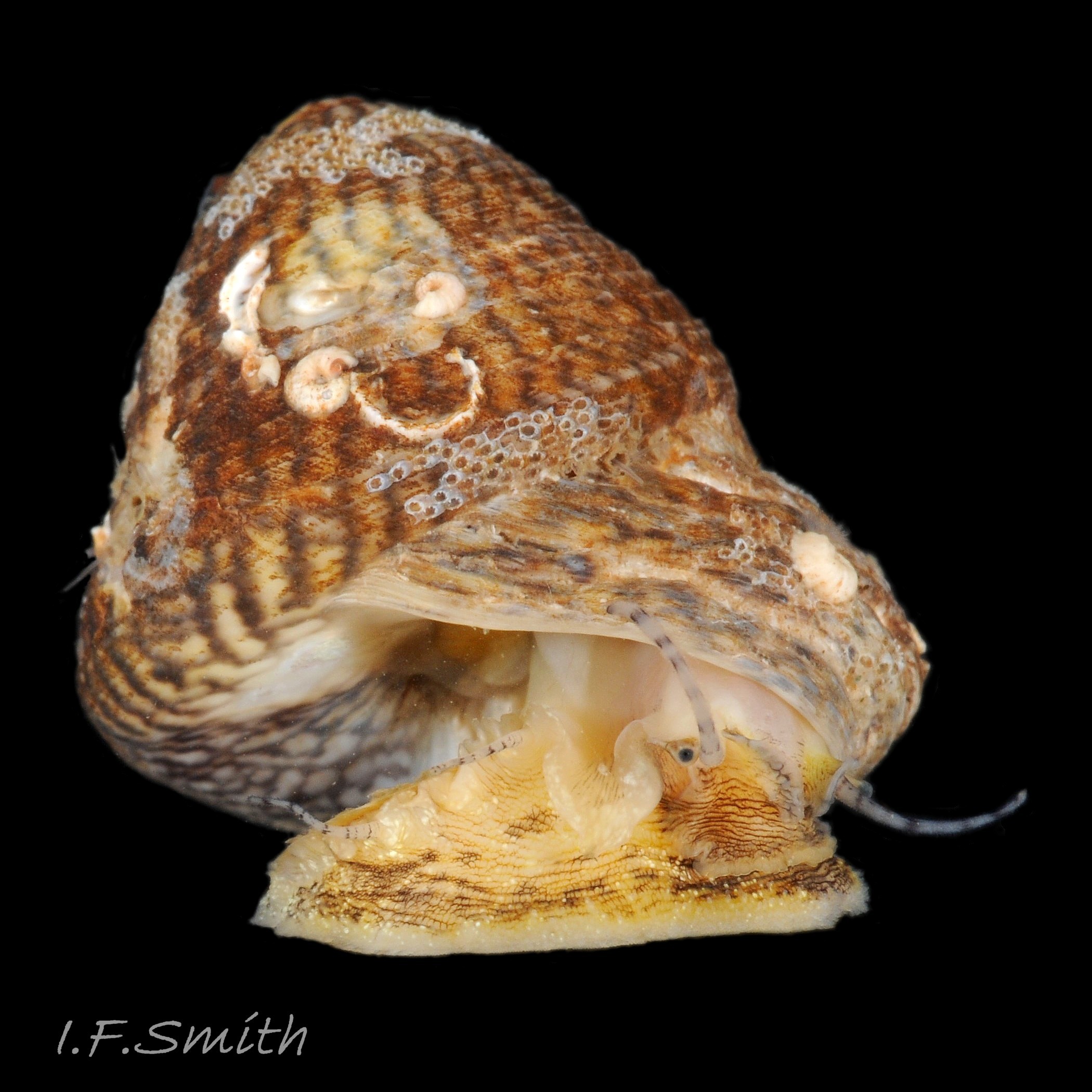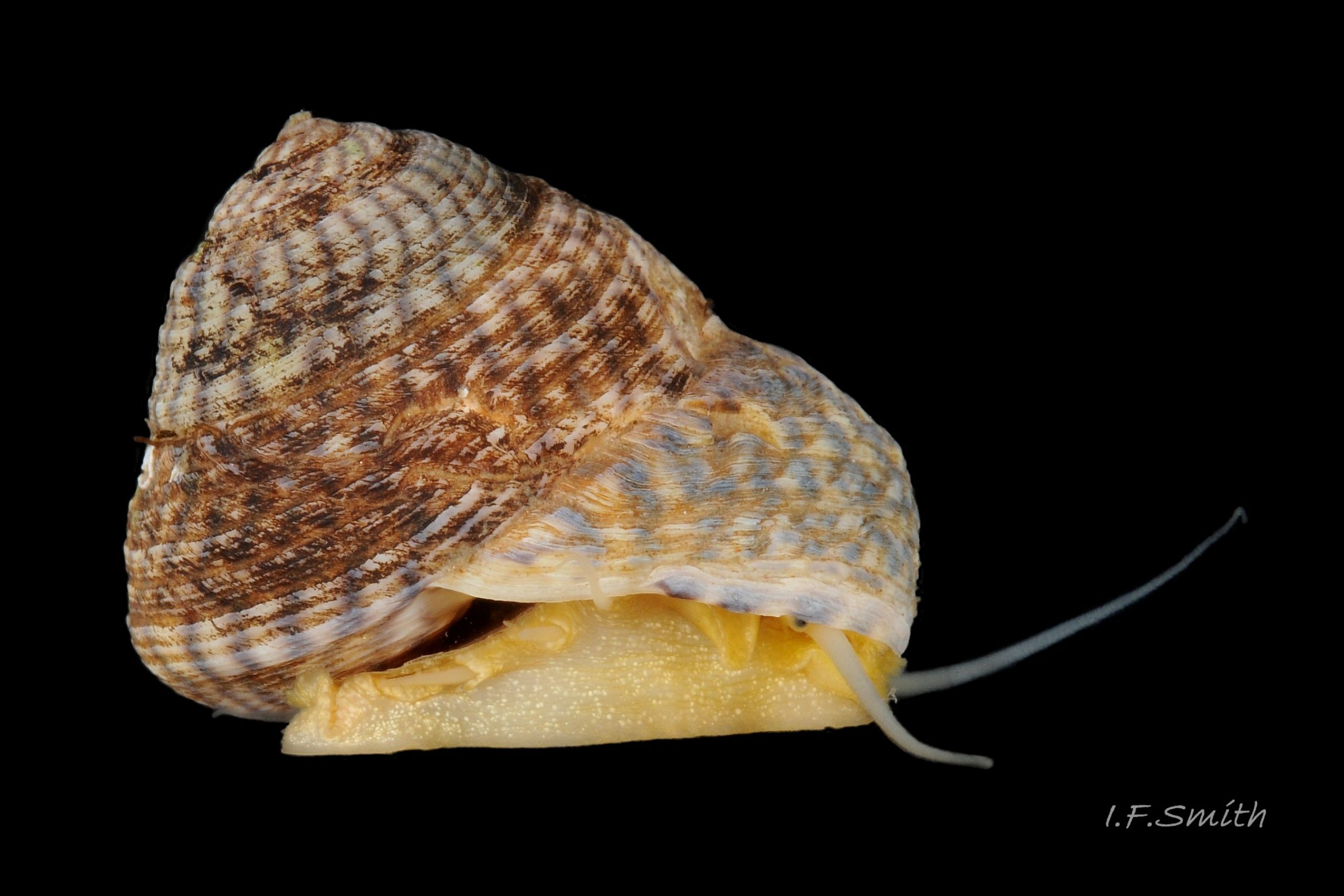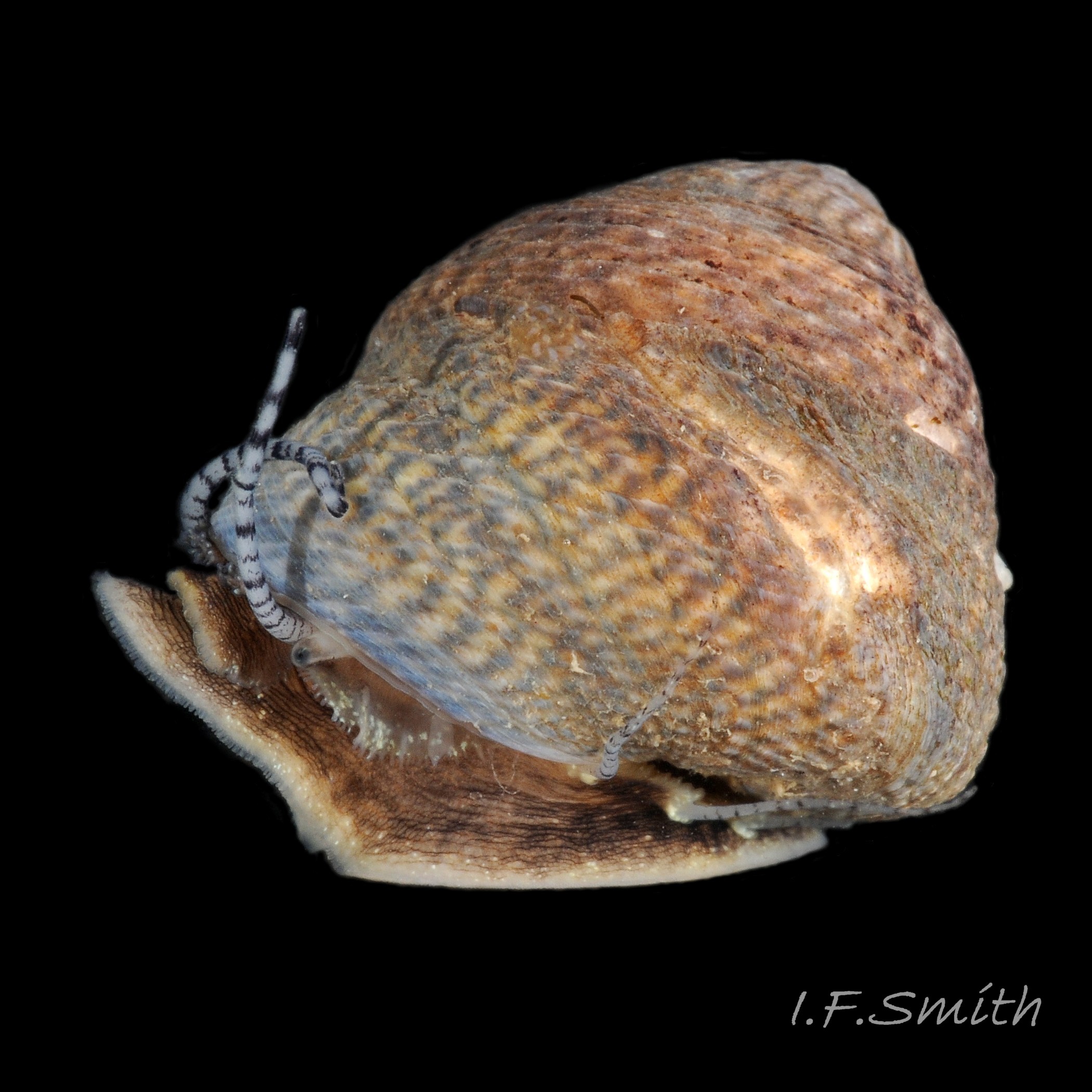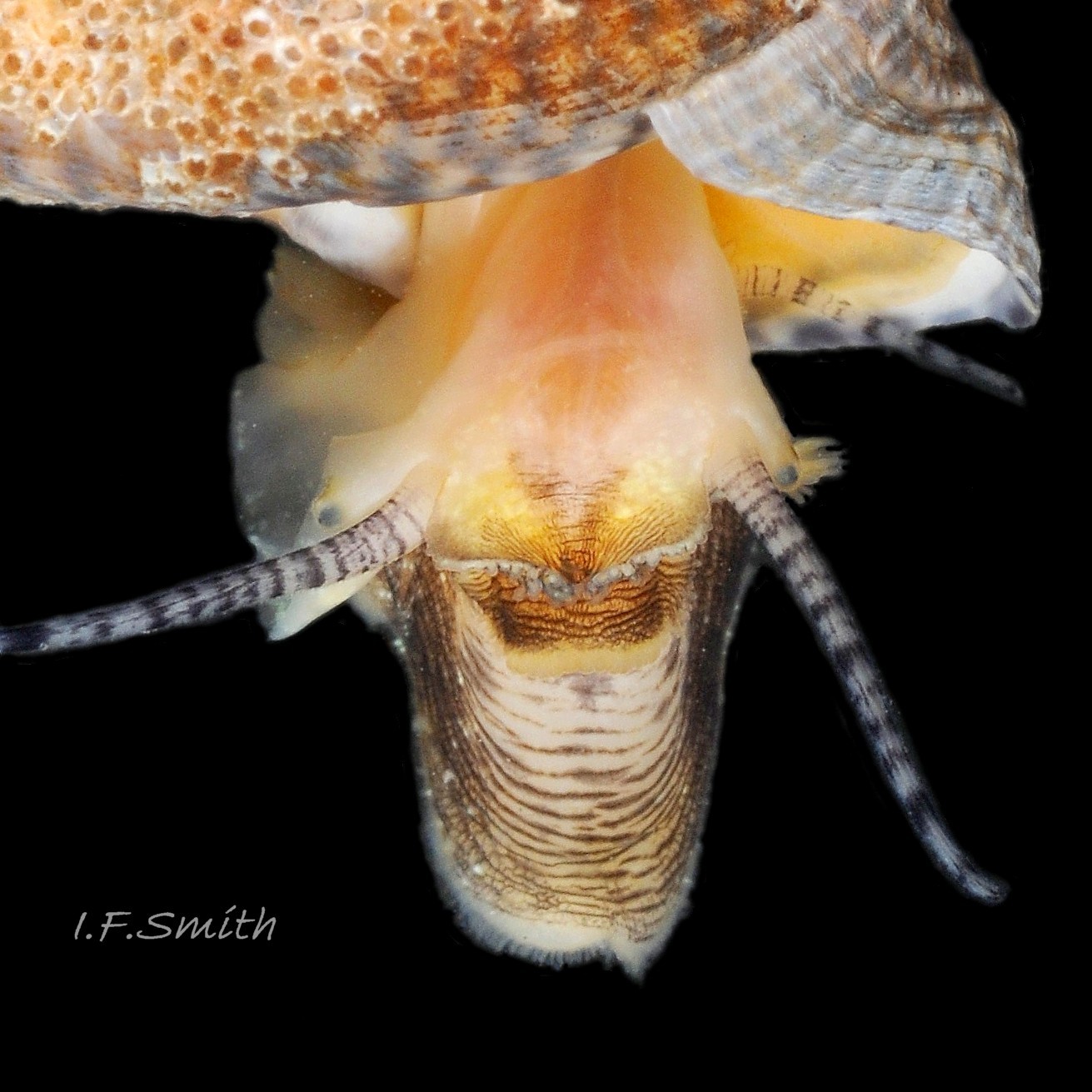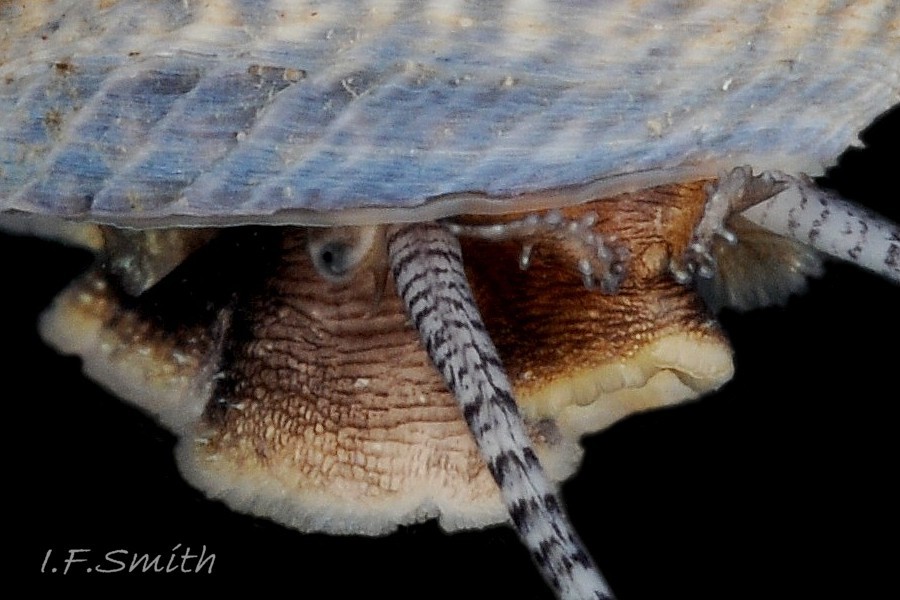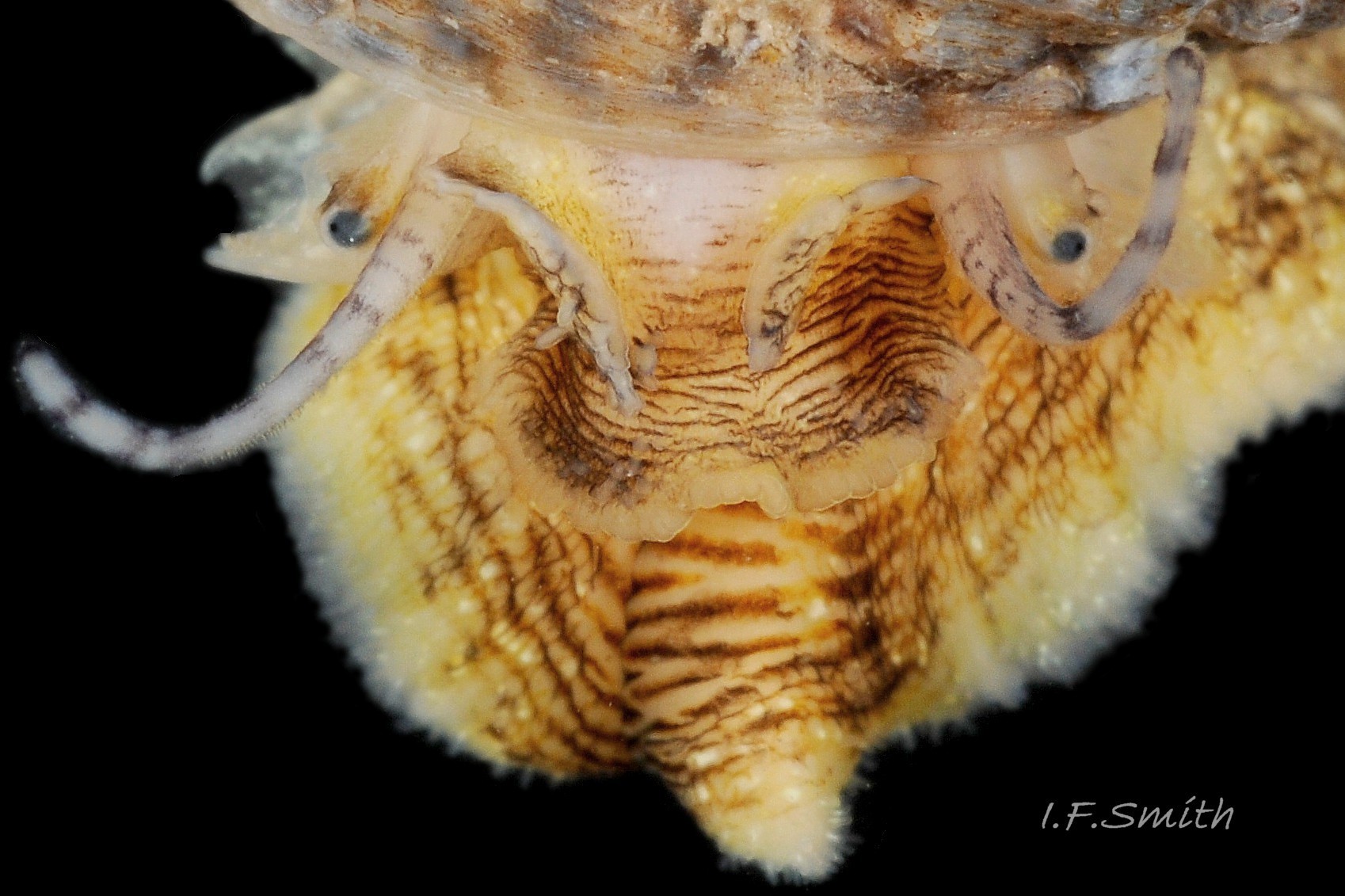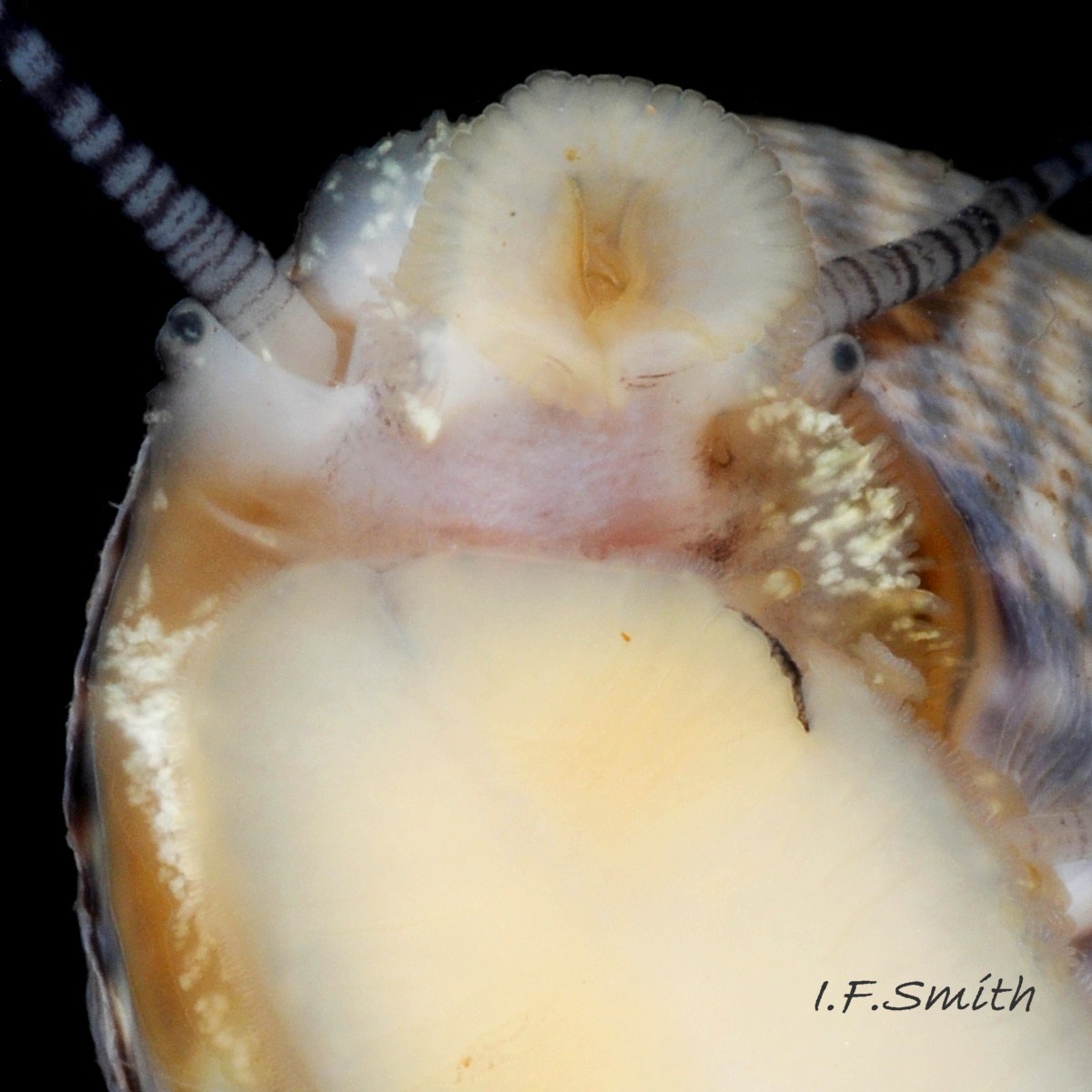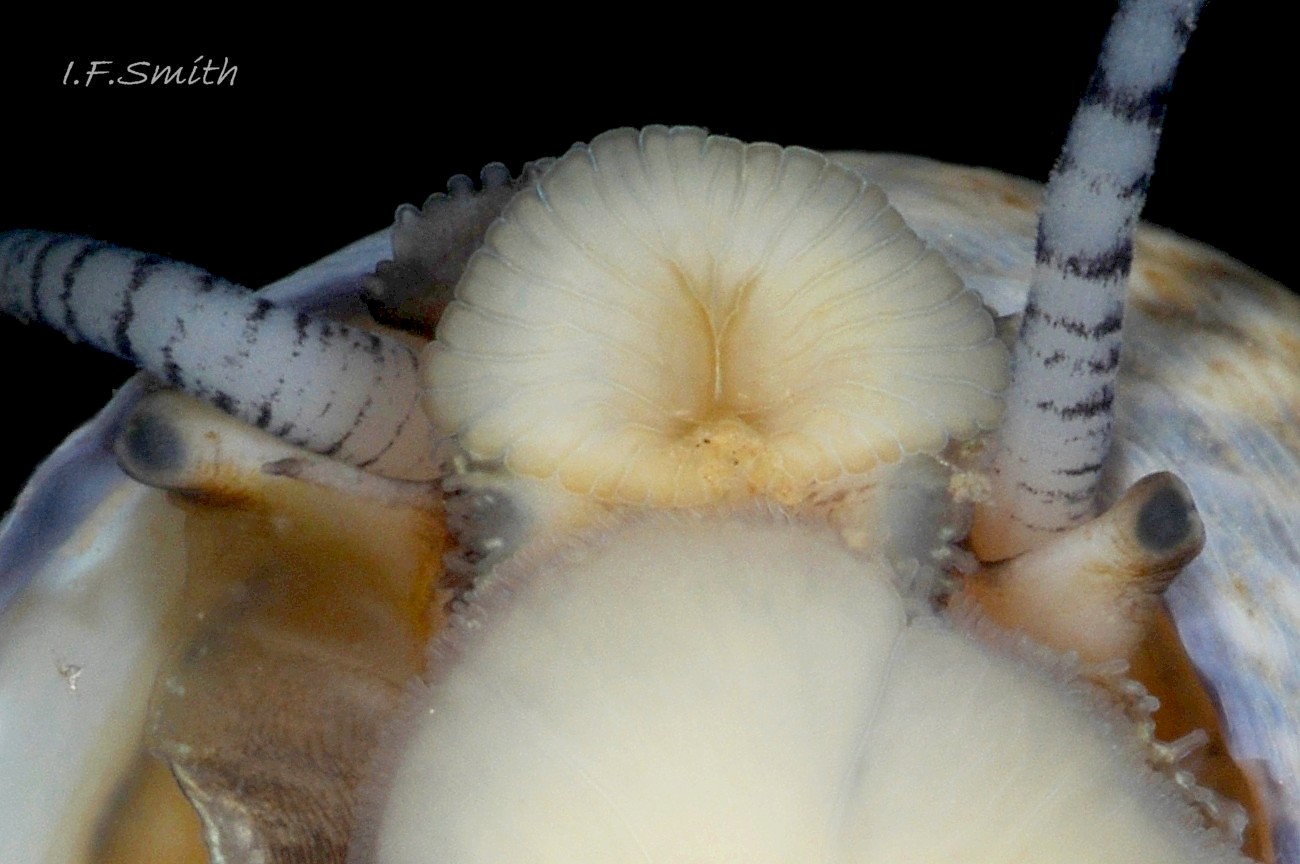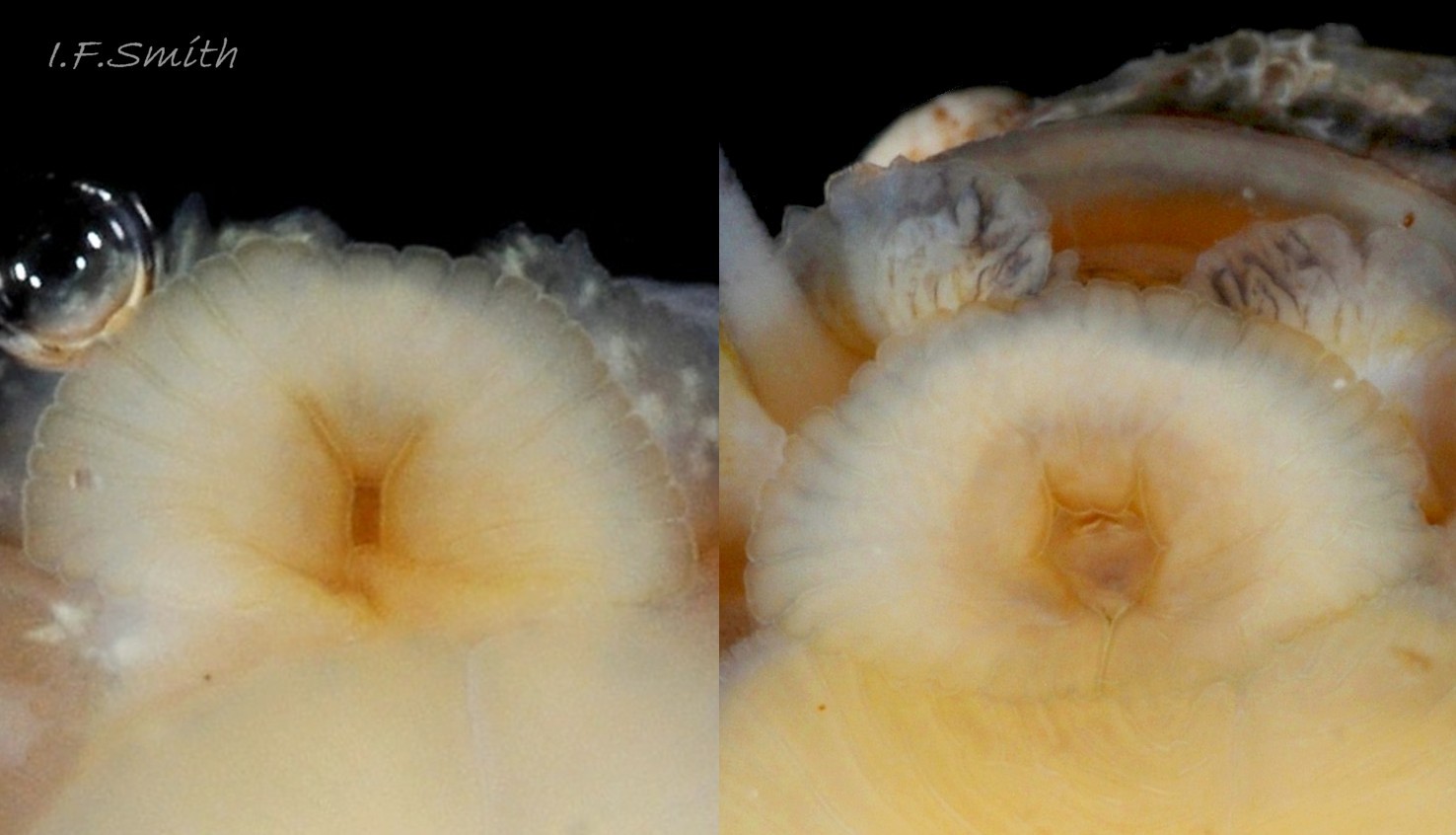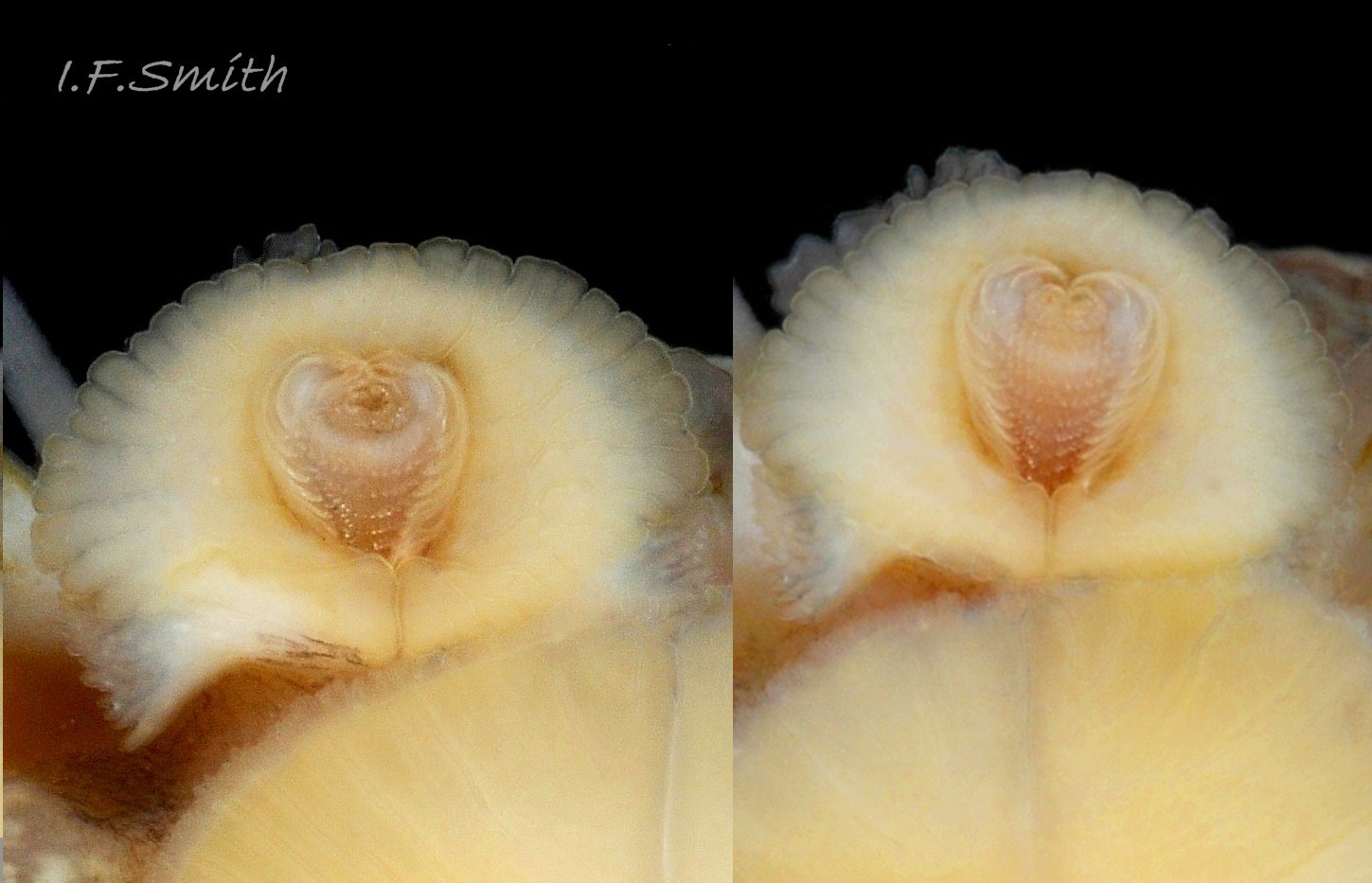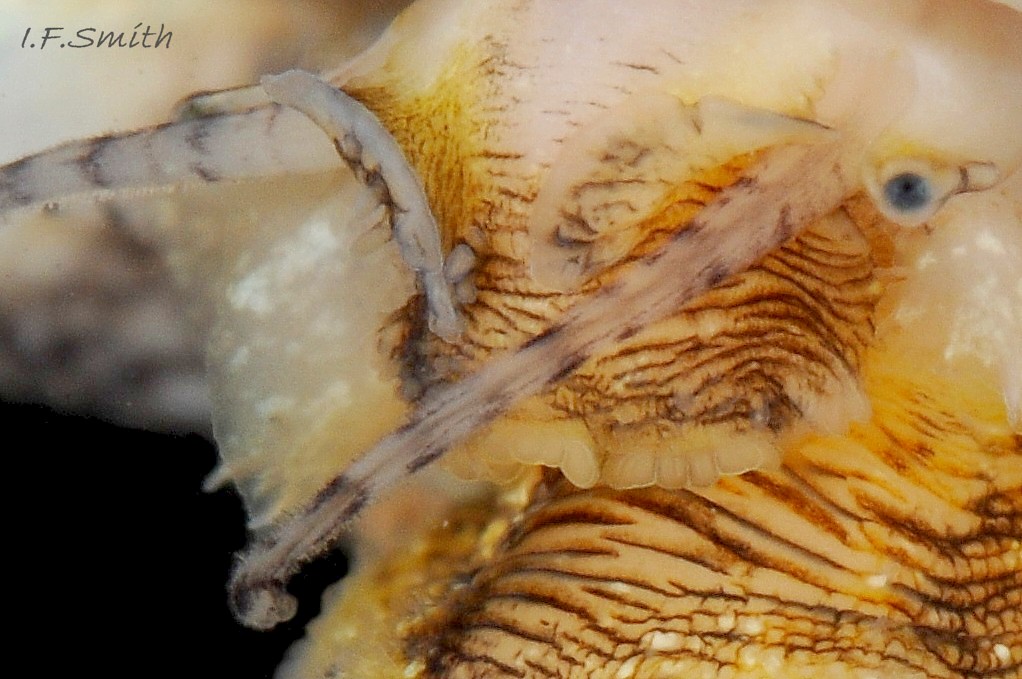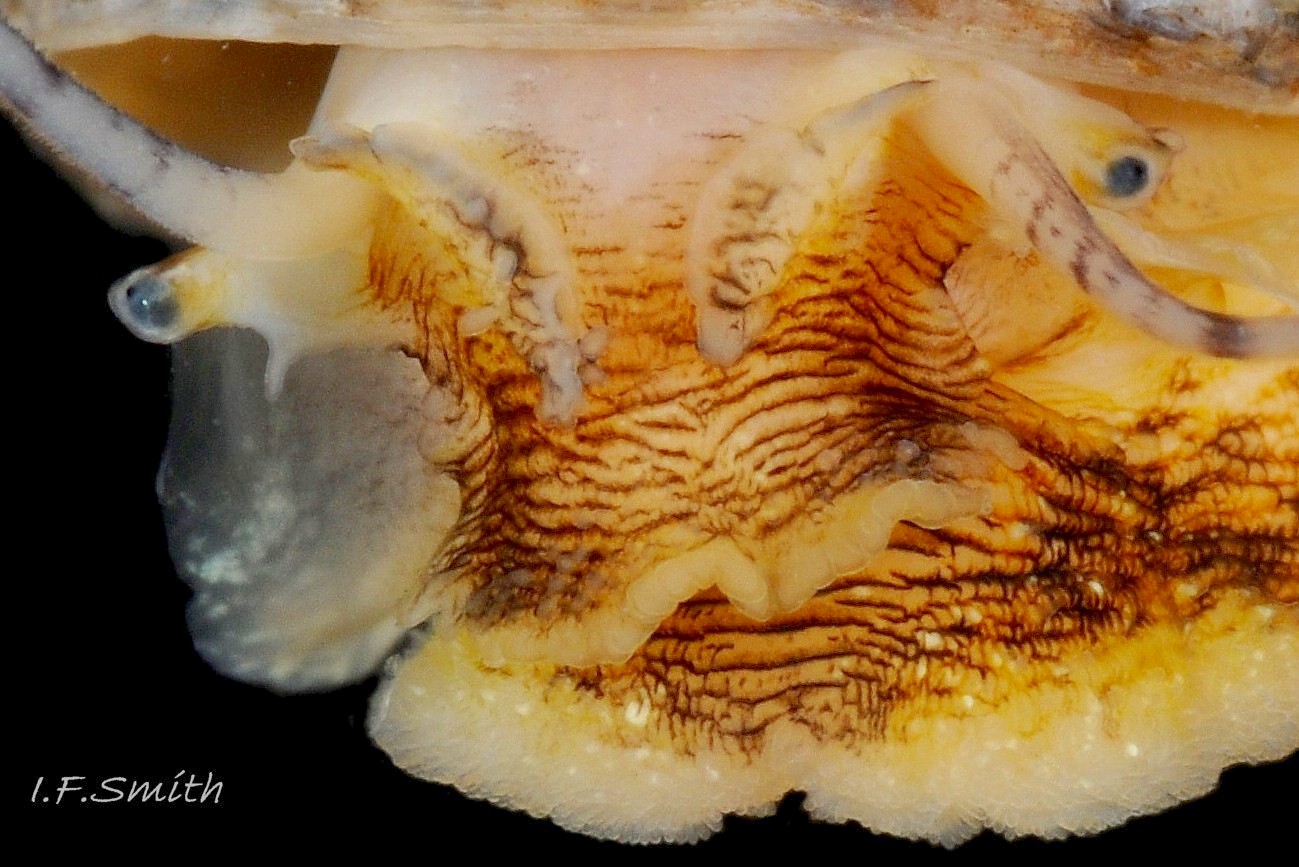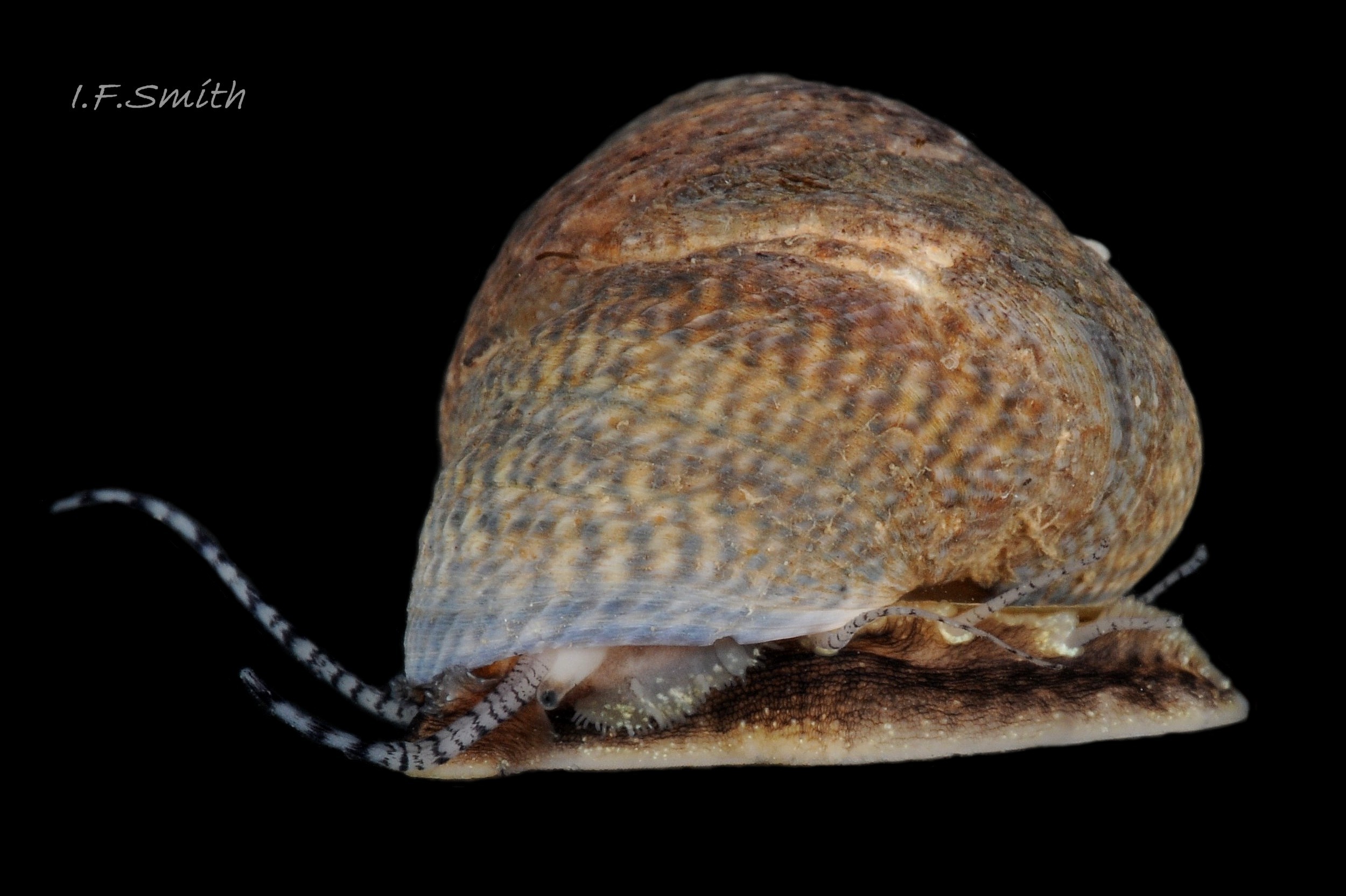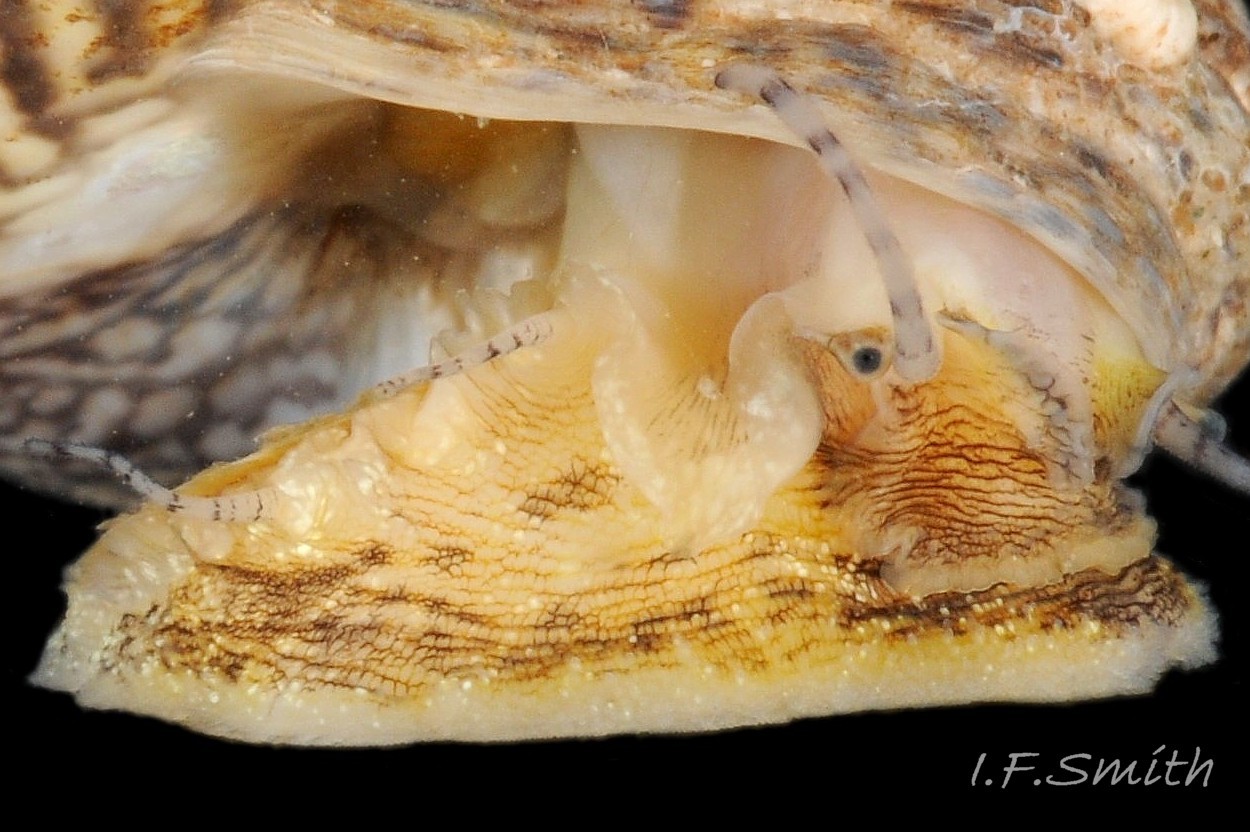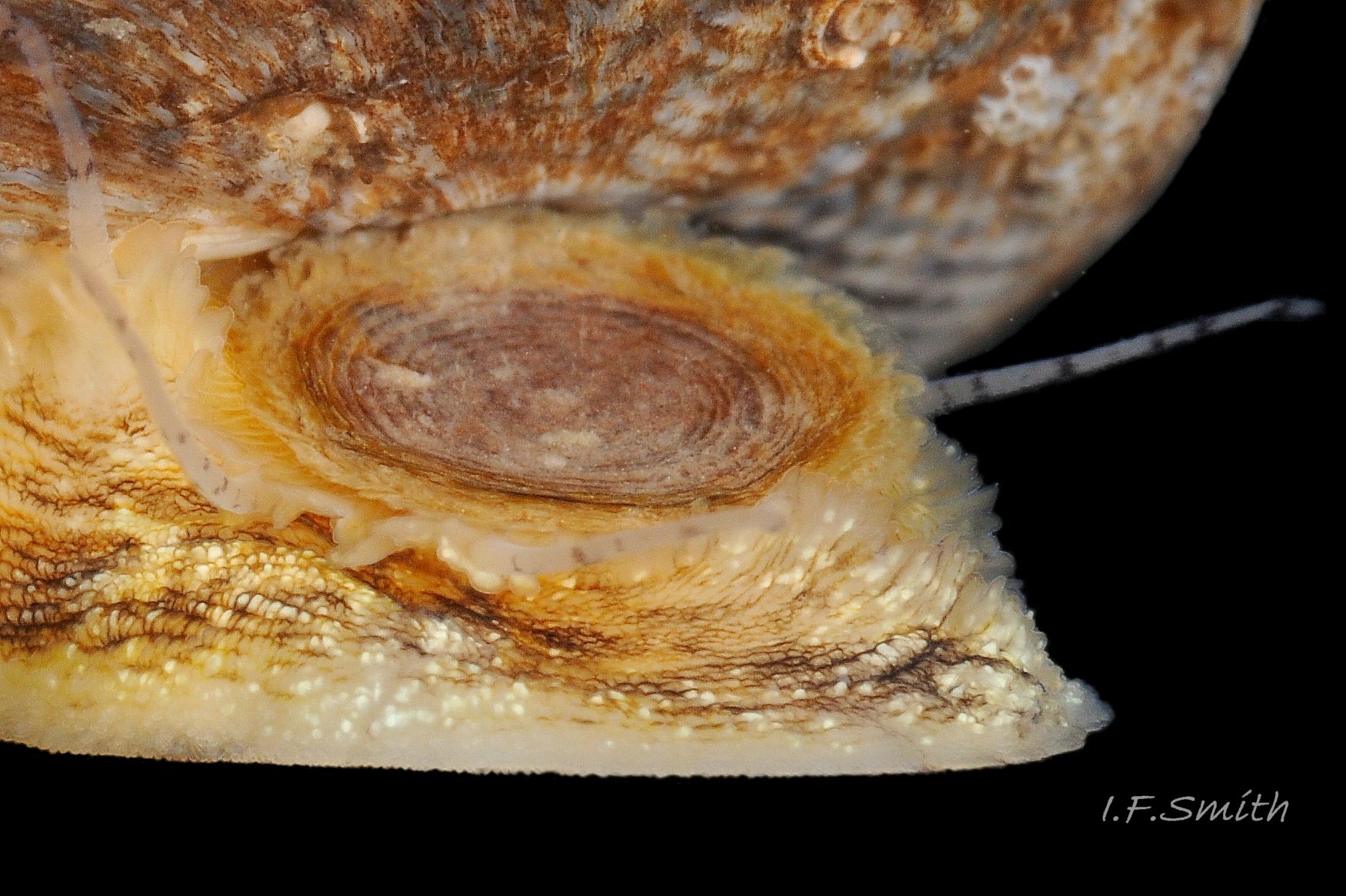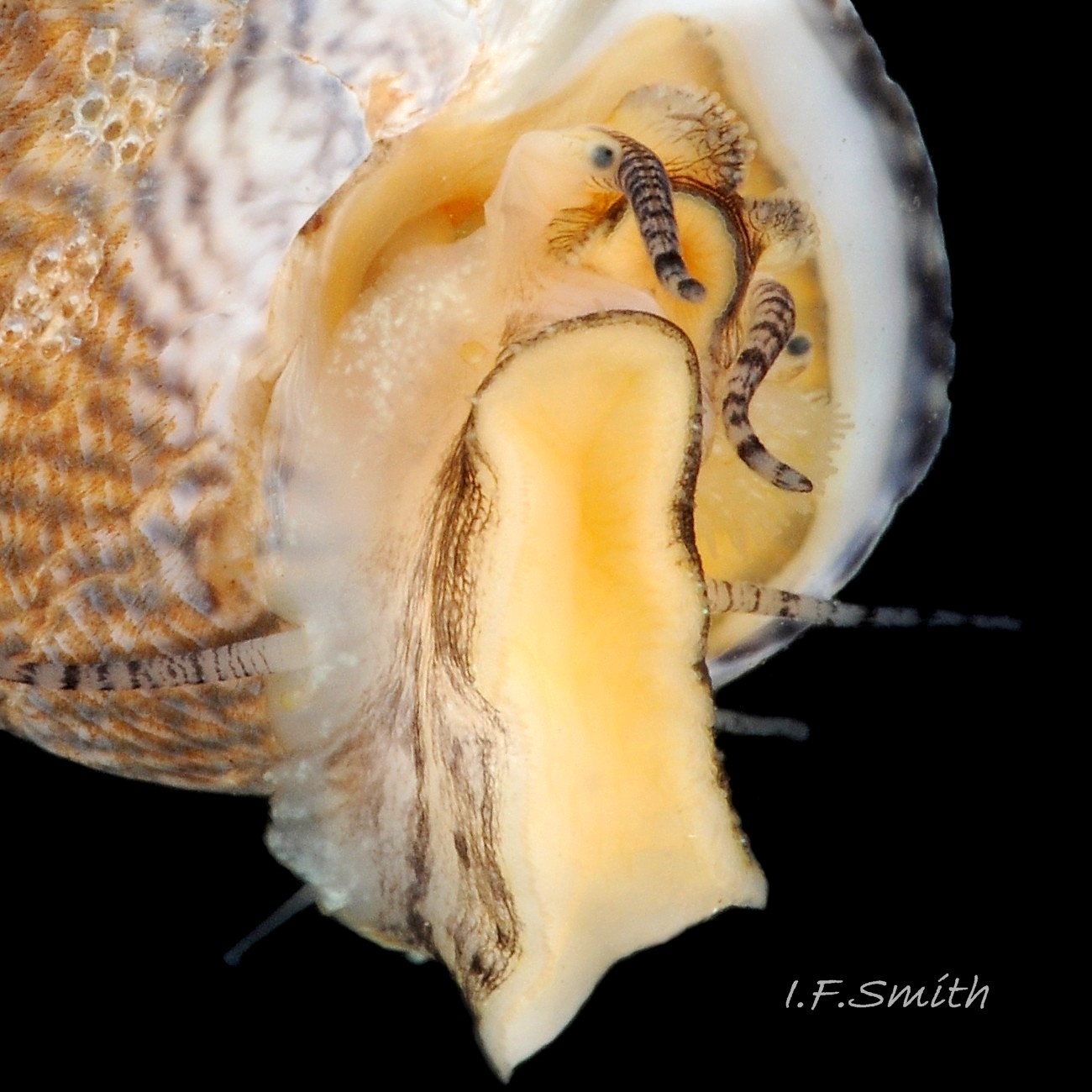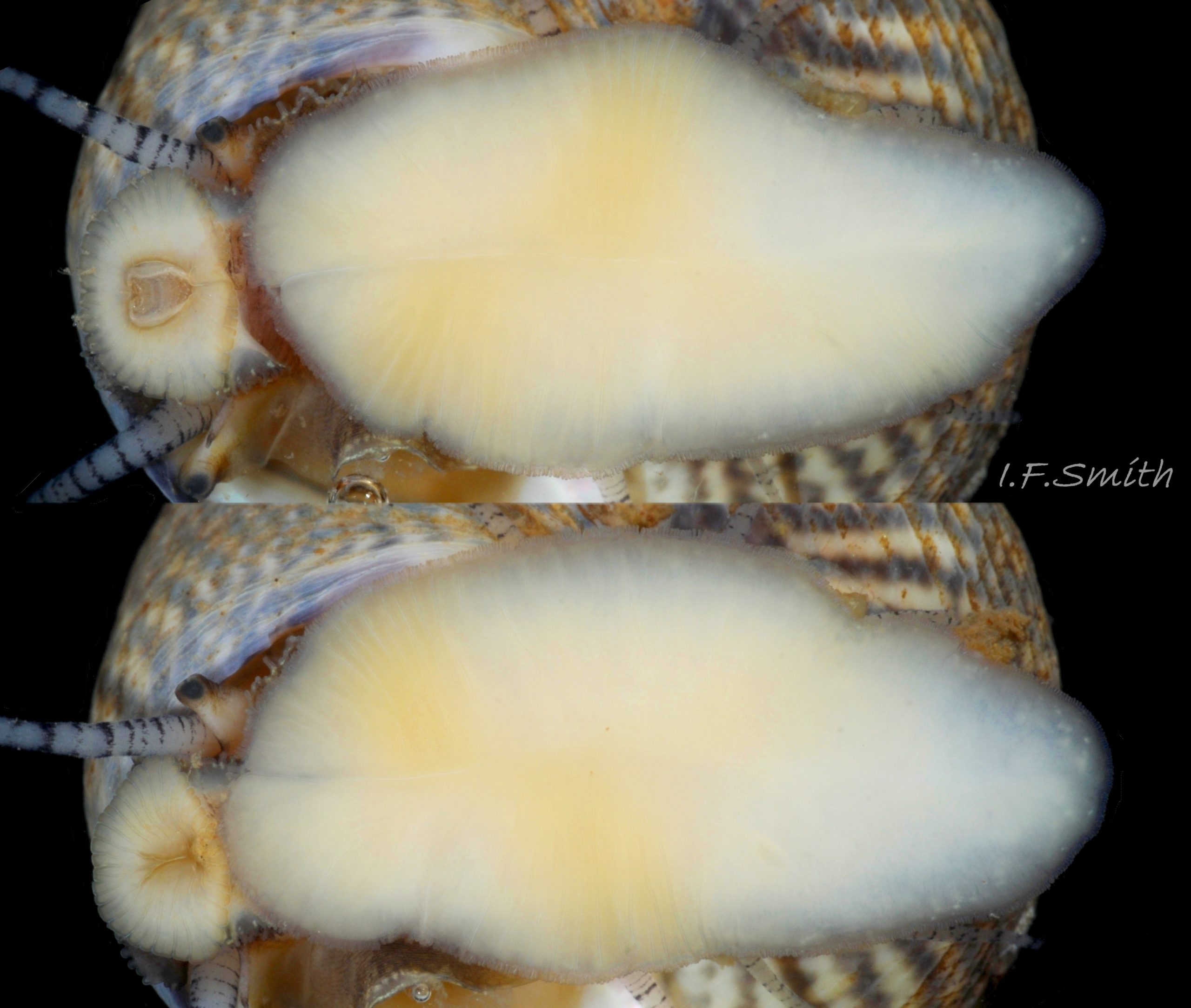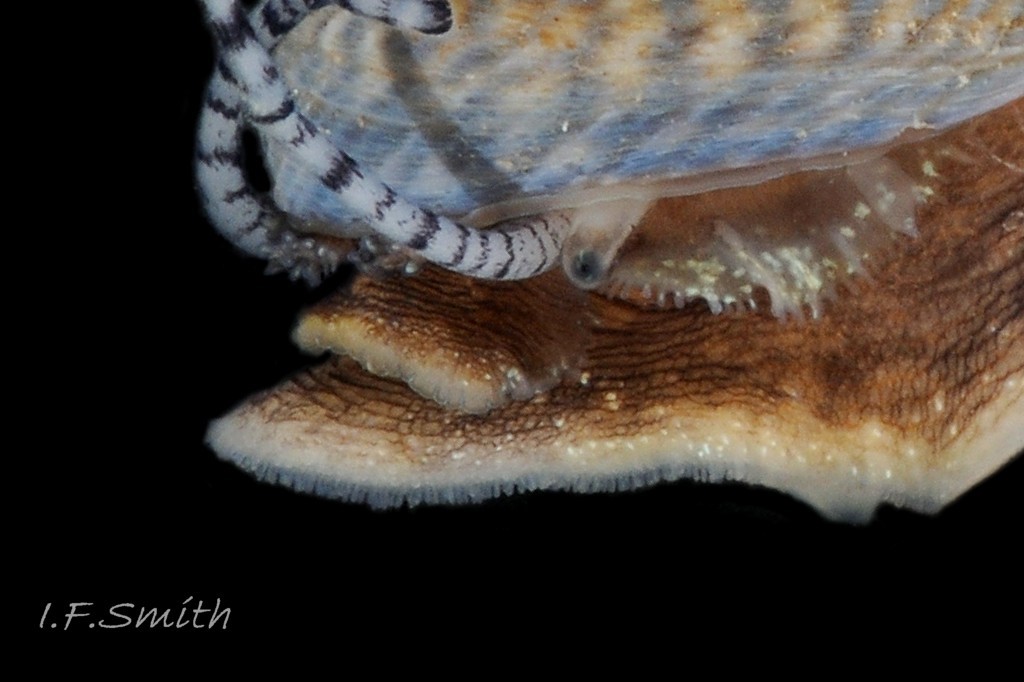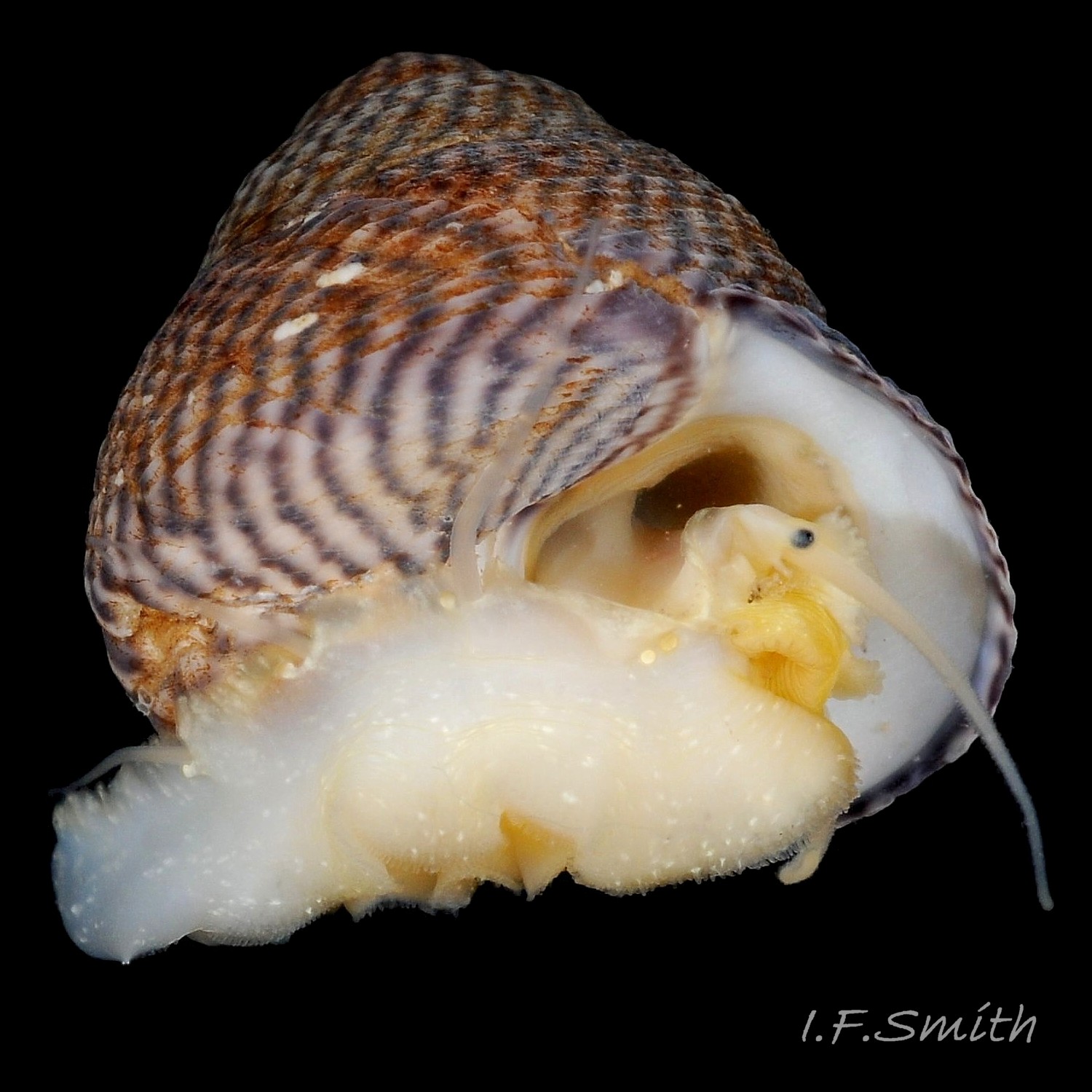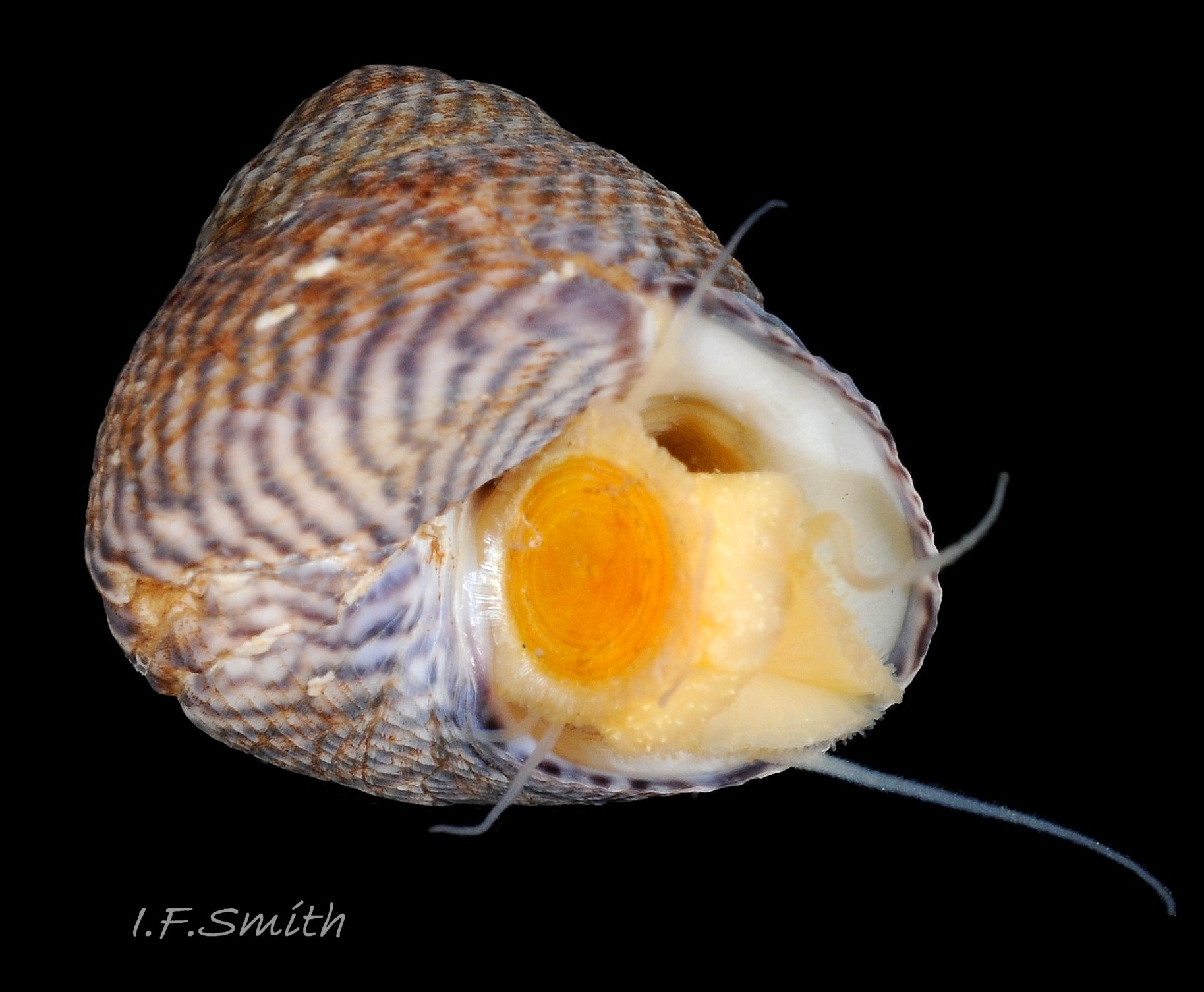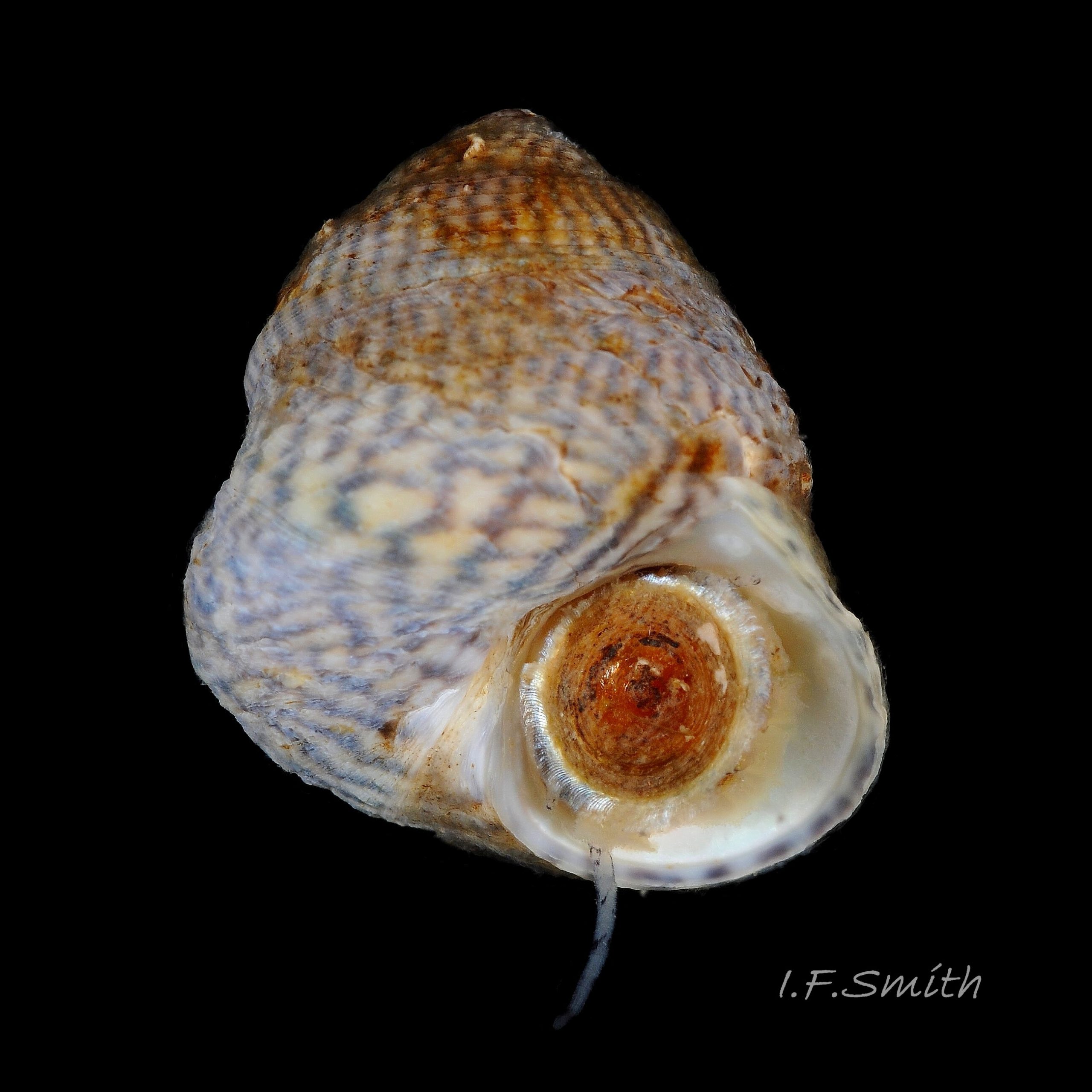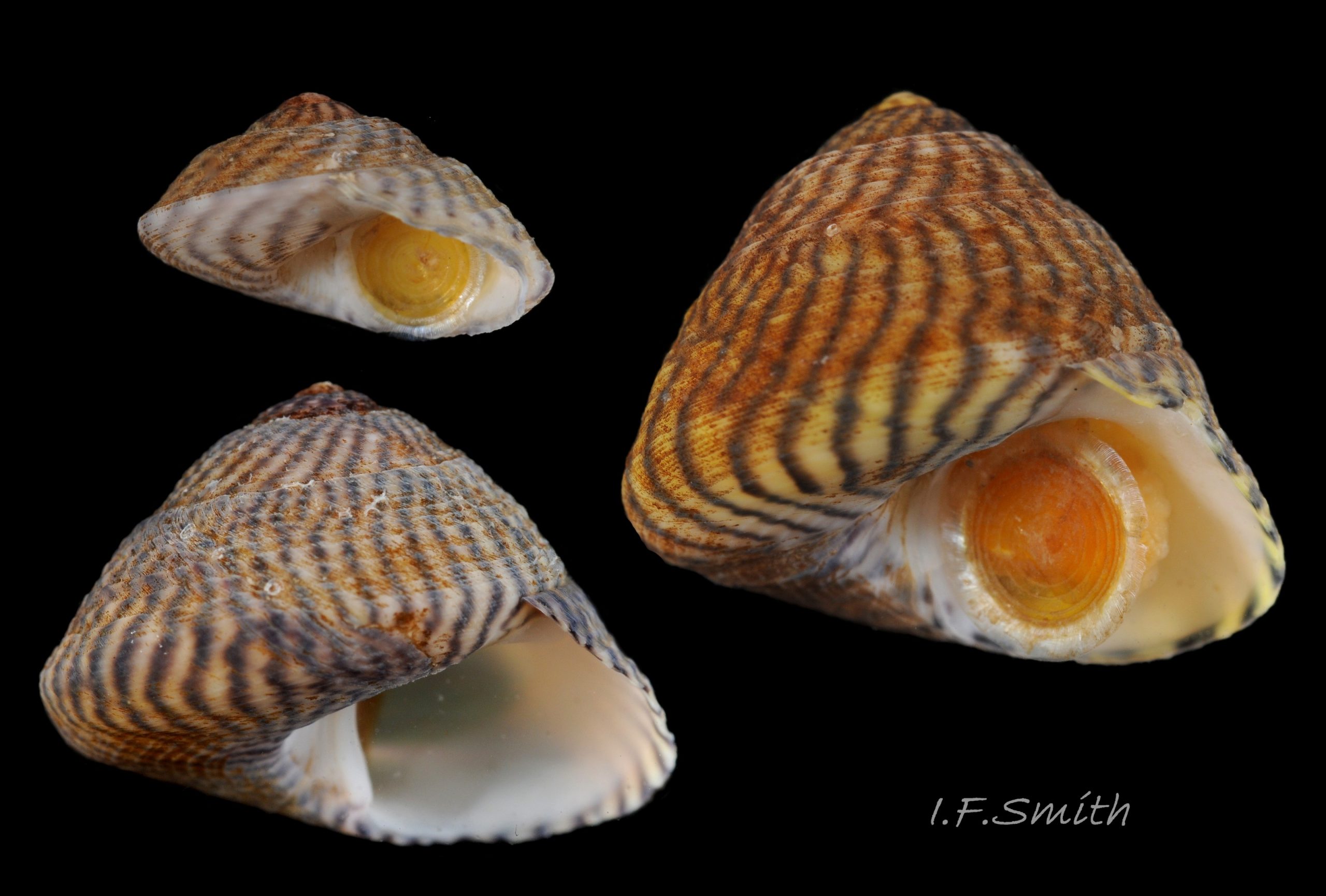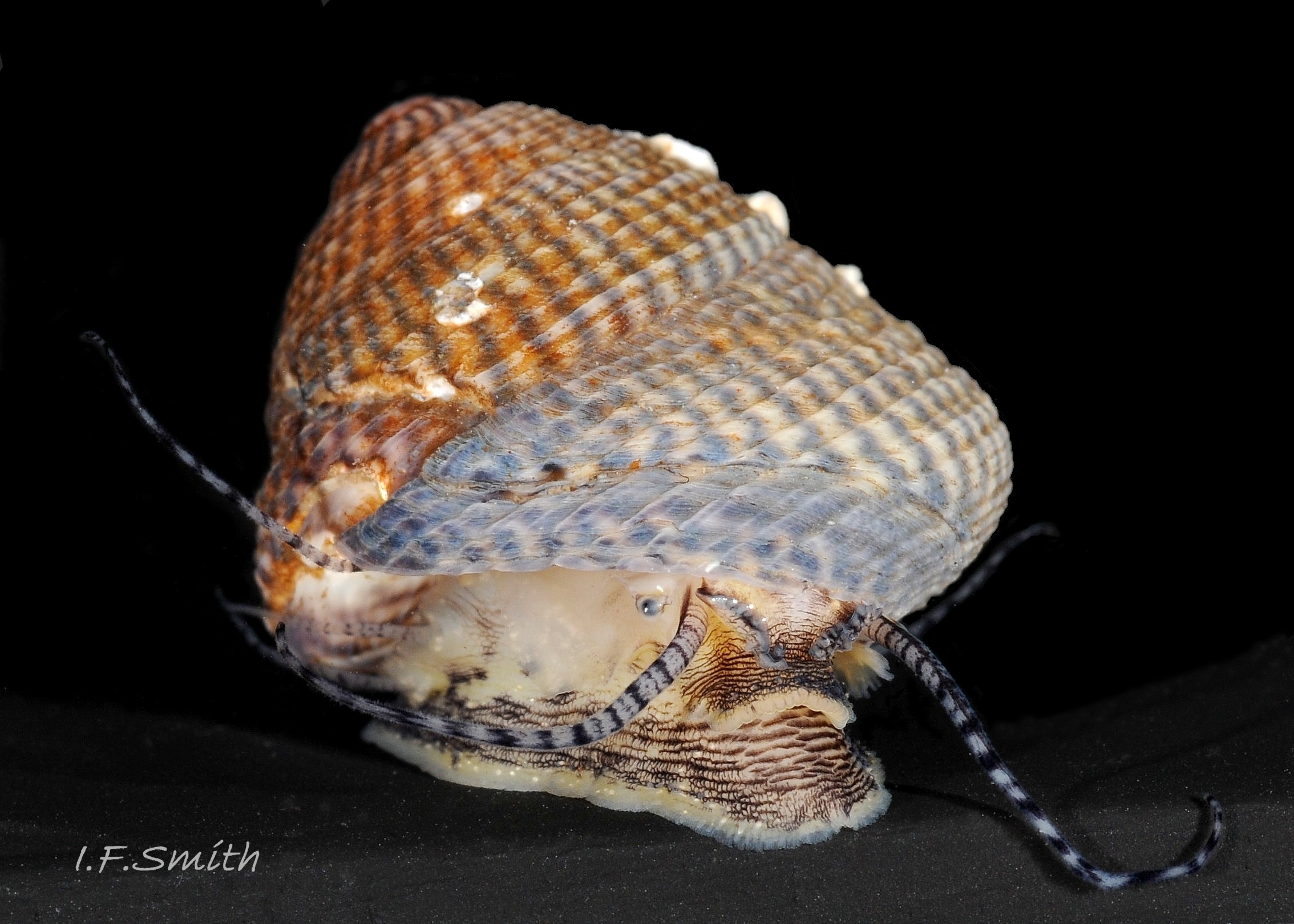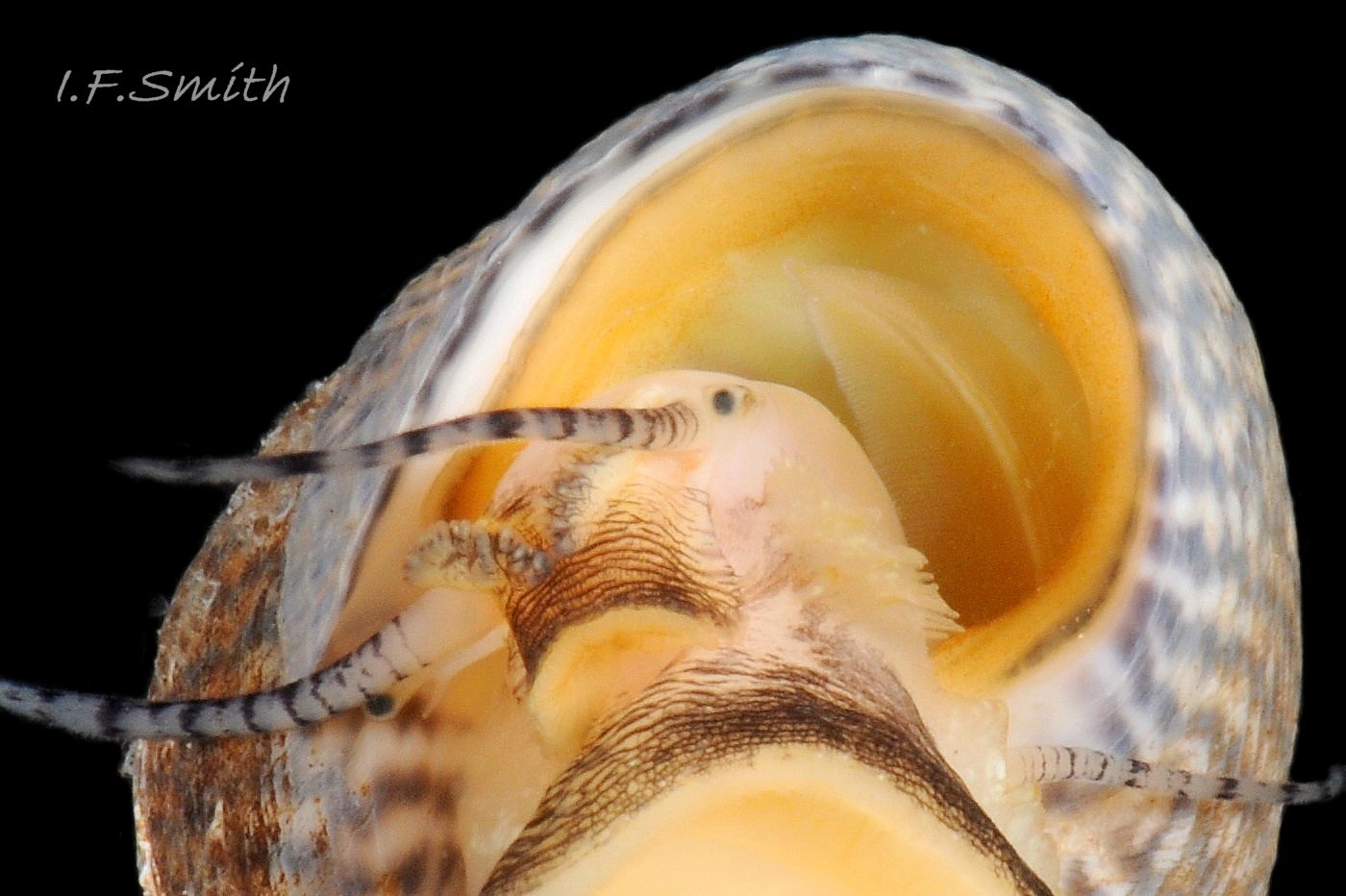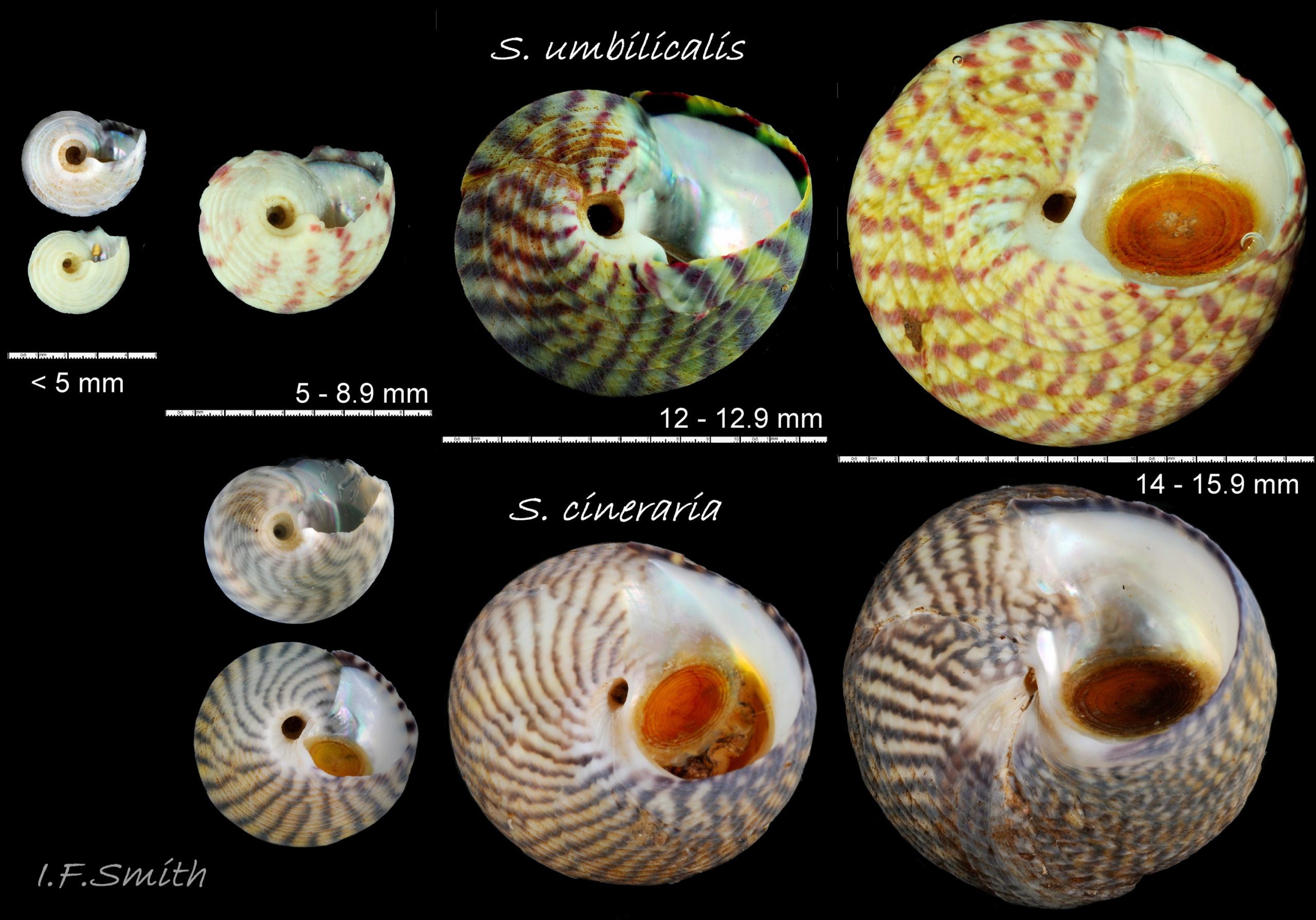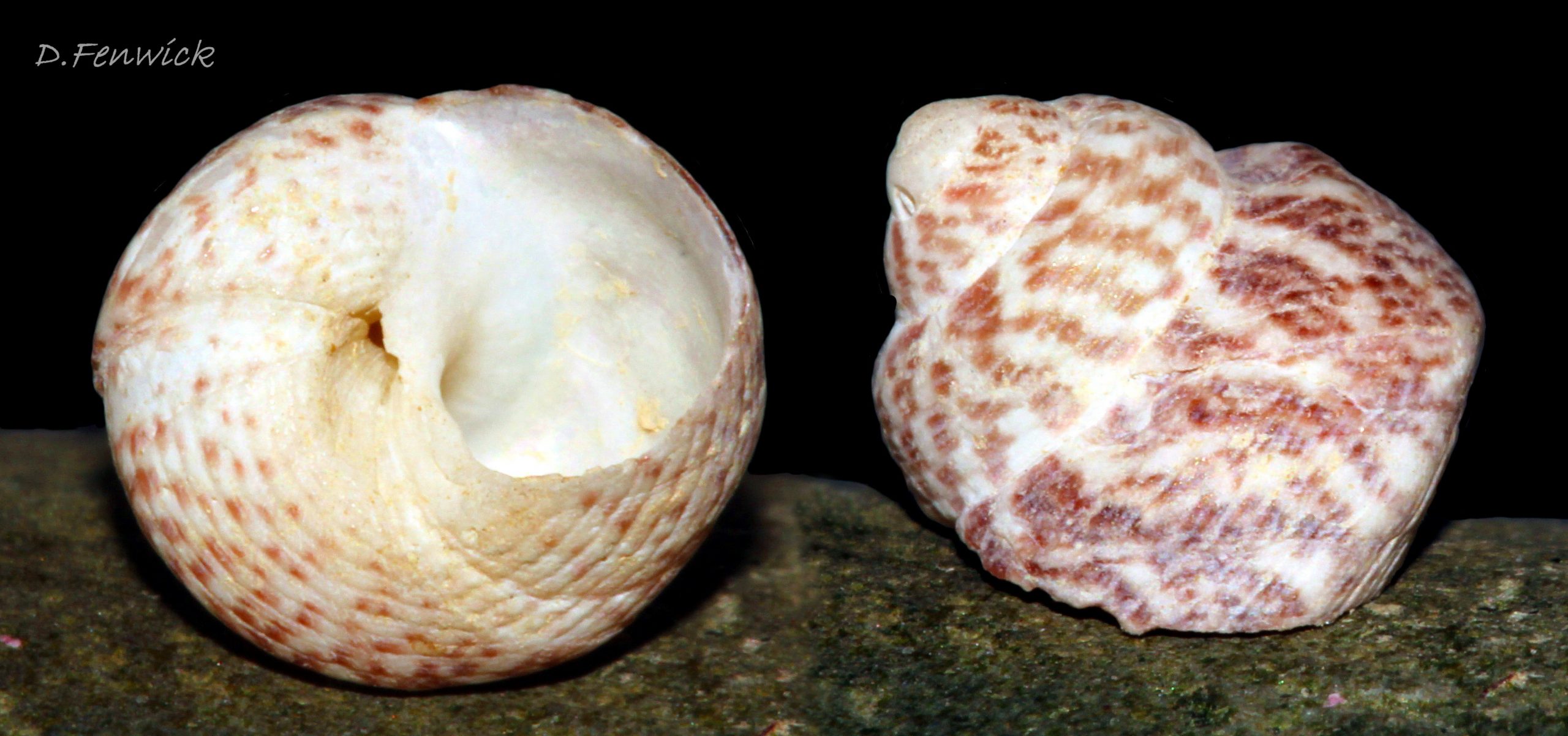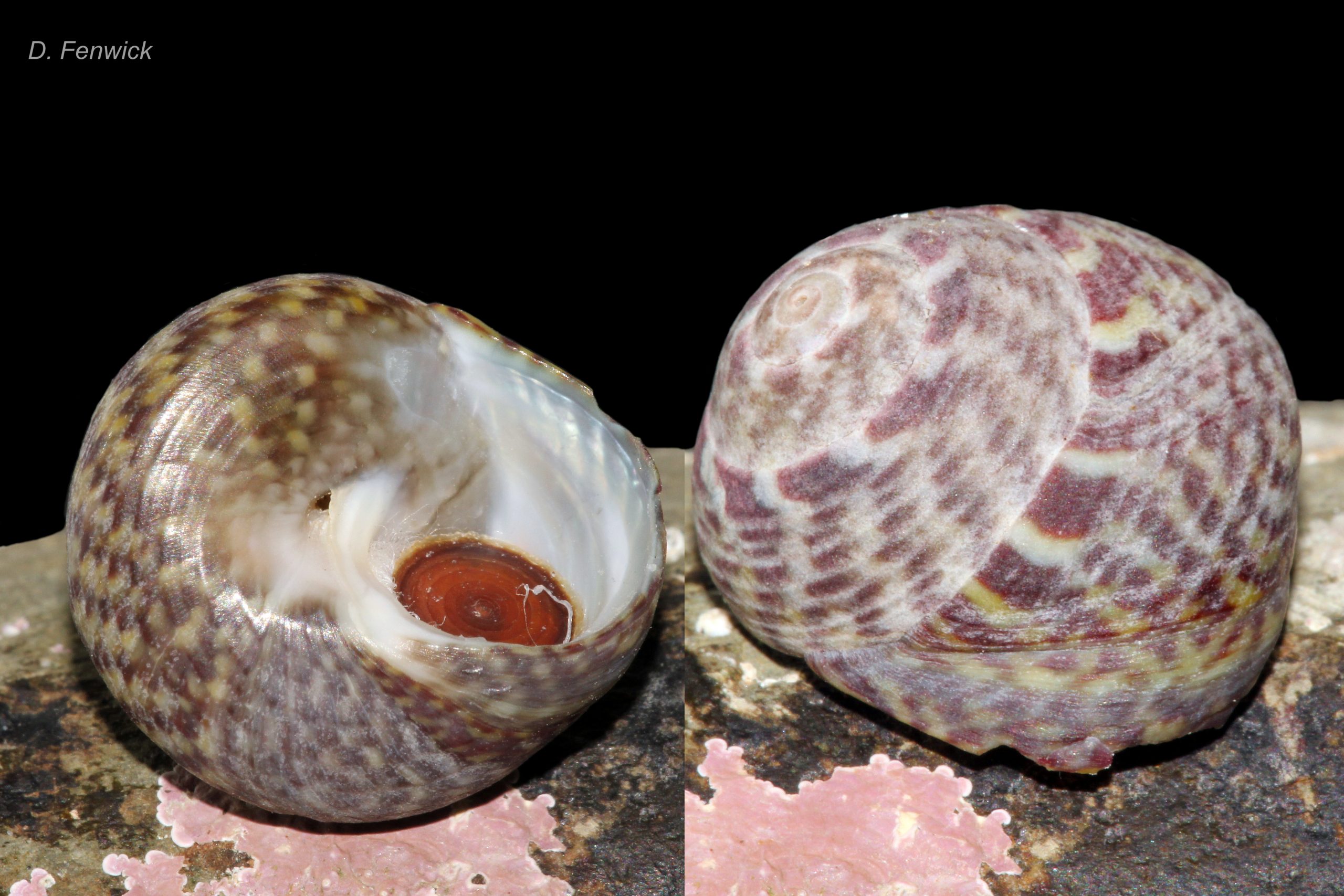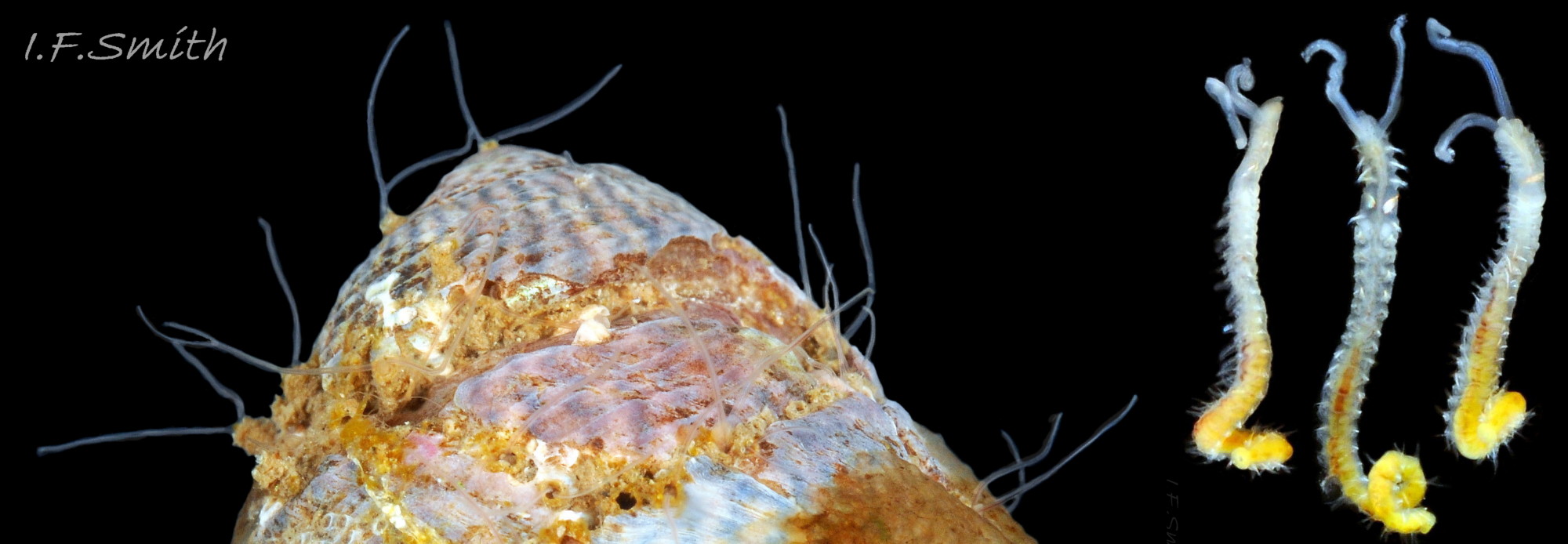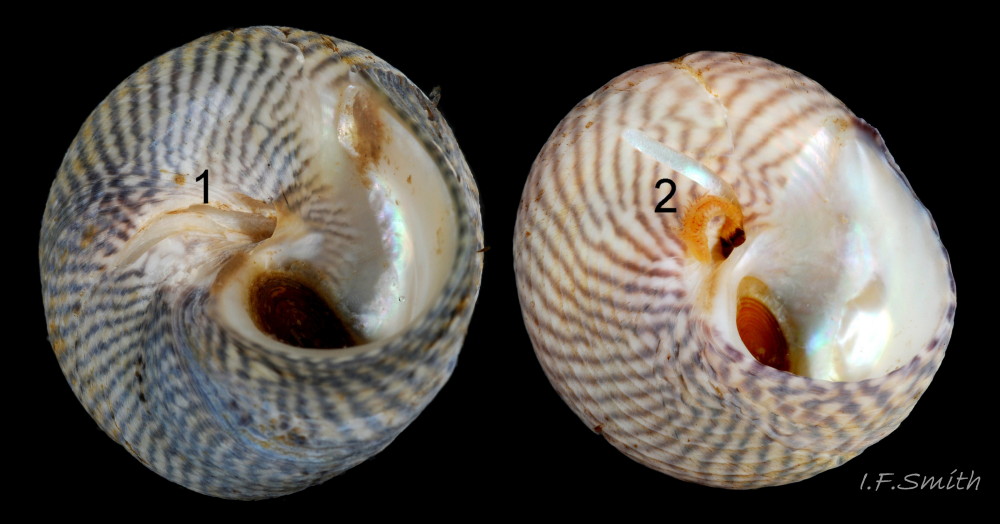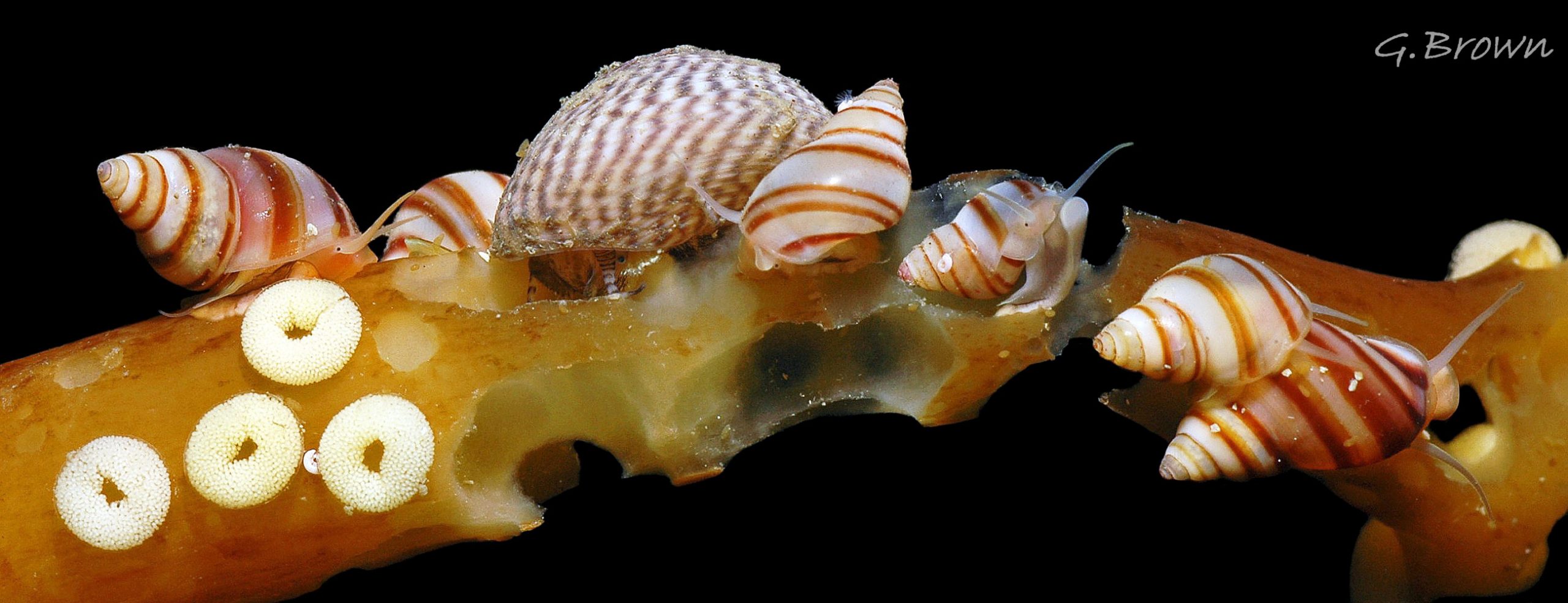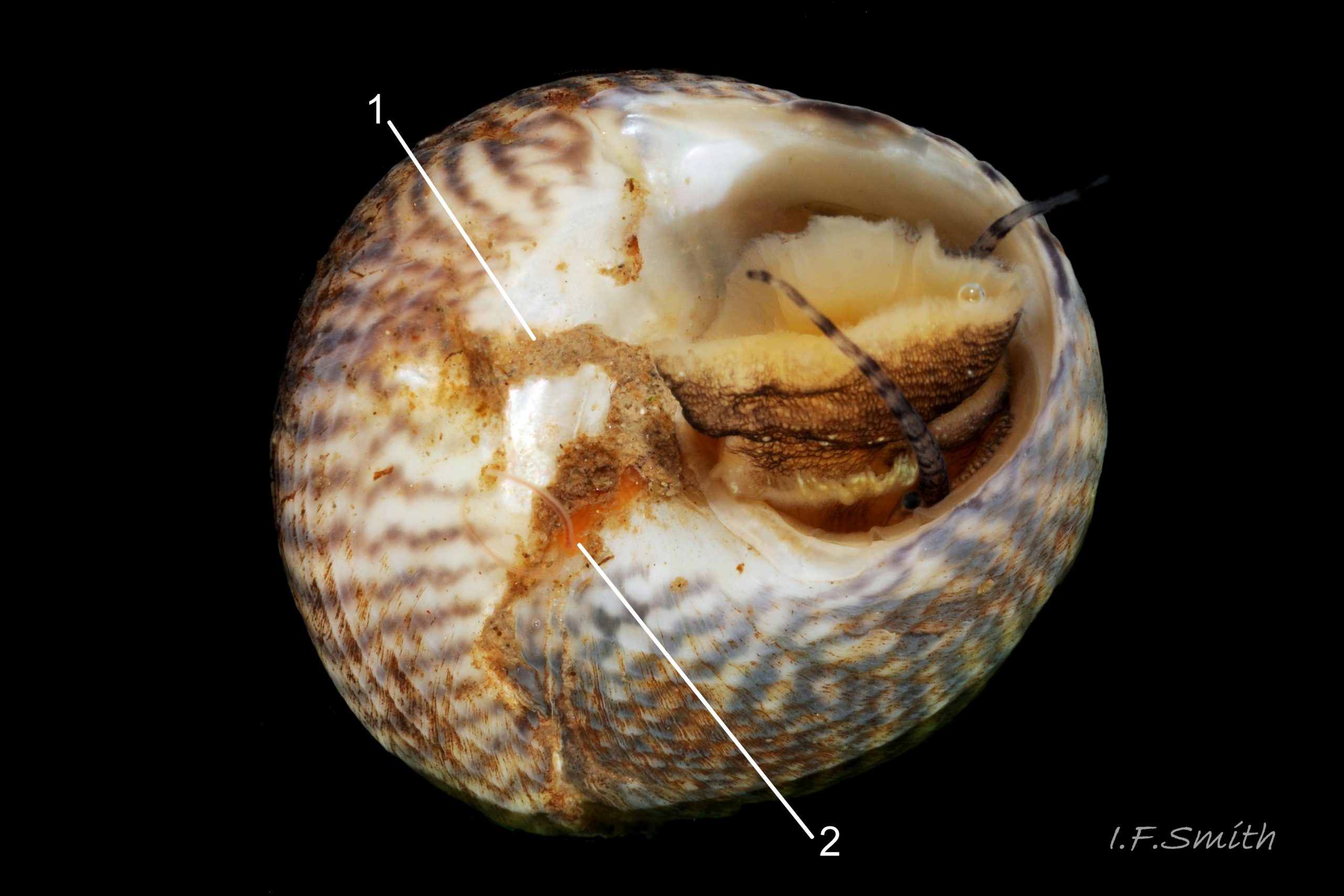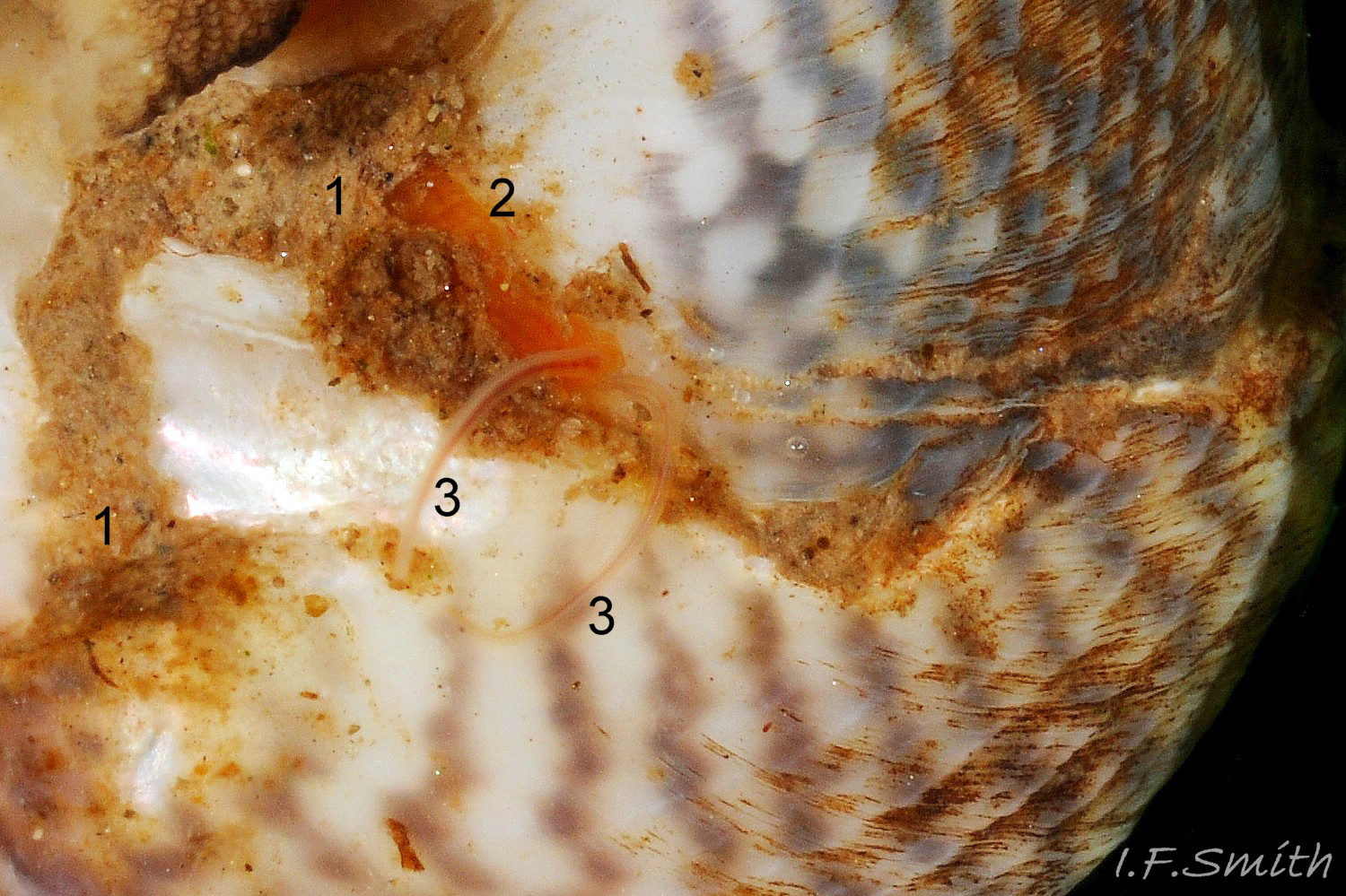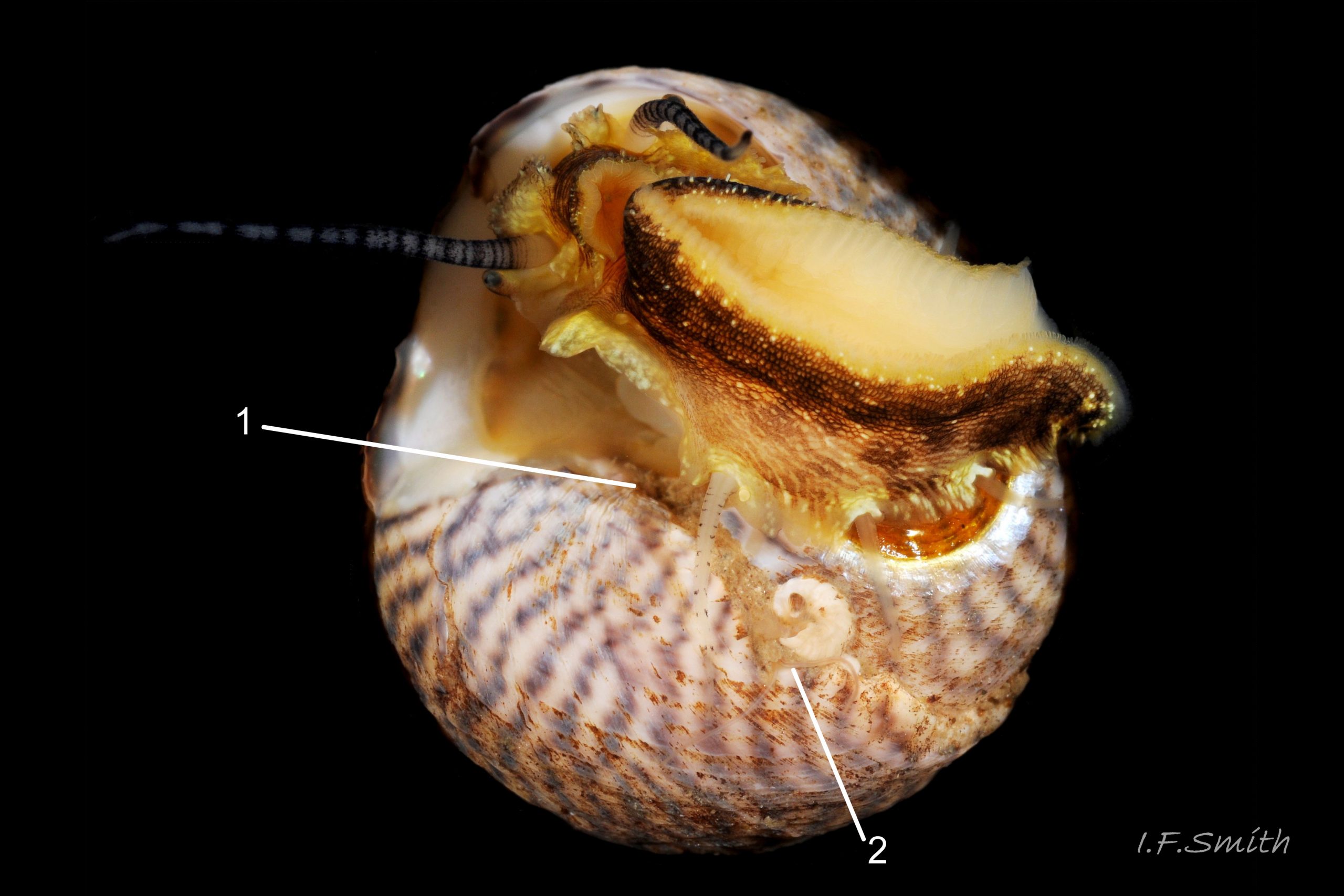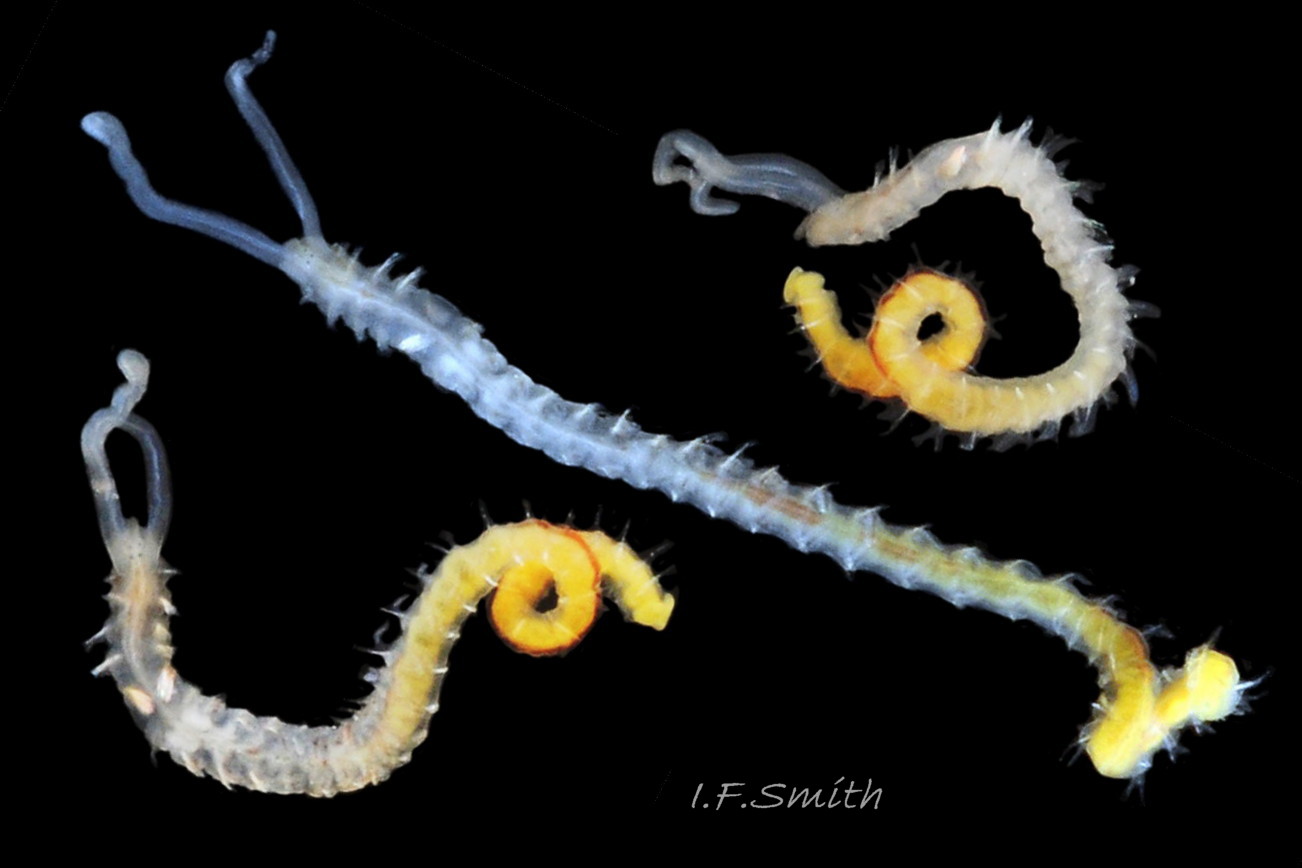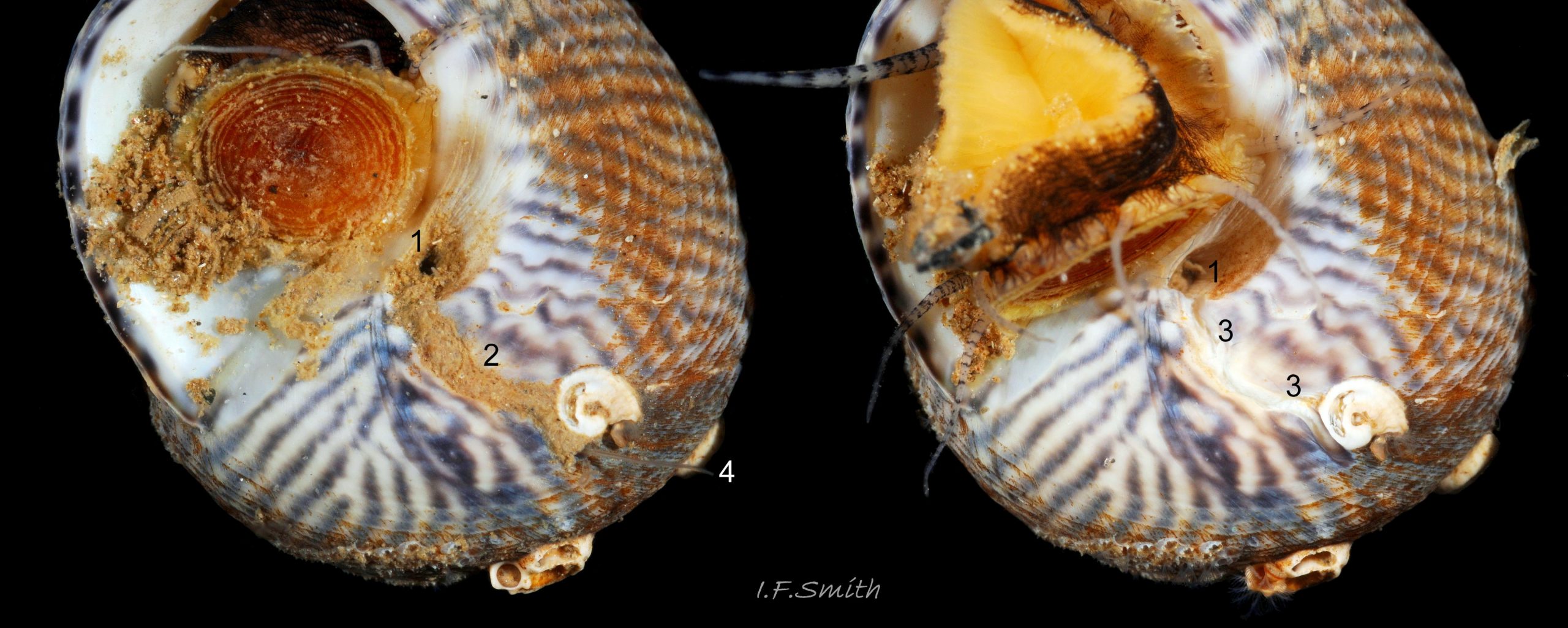Click image to enlarge with full caption. Main text below slider.
Steromphala cineraria (Linnaeus, 1758)
PDF available at www.researchgate.net/publication/348185176_Steromphala_ci…
Current taxonomy: World Register of Marine Species (WoRMS) www.marinespecies.org/aphia.php?p=taxdetails&id=141782
Synonyms:Trochus cinerarius Linnaeus, 1758 in Jeffreys, and in Forbes & Hanley, Trochus strigosus Gmelin, 1791; Scrobiculinus strigosus (Gmelin, 1791); Gibbula cineraria (Linnaeus, 1758).
Vernacular: Grey top shell, Grey topshell, Silver tommy [also used for G. umbilicalis] (English), Top môr llwyd, Gwichiad arian (Welsh), Gewone tolhoren, Asgrauwe tolhoren (Dutch), Graue Kreiselschnecke (German), Glattkjeglesnegl (Norwegian) Större puckelsnurrsnäcke (Swedish).
*GLOSSARY below.
Shell description
Breadth and height to 16mm. Early stages have low conoidal profiles with breadth much greater than height; becoming high conoidal (like straw beehive) with breadth about equal to height when fully grown 01 Steromphala cineraria & 28 Steromphala cineraria. But heights can vary on shells of similar breadth 02 Steromphala cineraria & 28 Steromphala cineraria. Sutures distinct, but less so on fully grown shells 03 Steromphala cineraria . Moderate spire, body whorl about 70% of height 01 Steromphala cineraria . Blunt apex, often eroded exposing silver nacre layer 03 Steromphala cineraria . About 7 to 10 raised, slightly nodose, spiral lines above periphery on body whorl, continue, decreasing in number, onto whorls of spire. Over 13 raised spiral lines (not always clear) on body whorl below angulated periphery (keel) i.e. on base of shell 04 Steromphala cineraria ; hidden on spire whorls by overlapping subsequent whorl . Sharp peripheral keel on small specimens becomes rounded with increasing size 01 Steromphala cineraria . Umbilicus large and round on small shells to about 8mm broad, progressively narrowing ellipse with growth 04 Steromphala cineraria . Umbilicus often sealed over by columellar lip on largest shells 27 Steromphala cineraria , but kept open if occupied by acid secreting Polydora sp. worm 04 Steromphala cineraria . Aperture approximately semi-circular, about 40% of height 01 Steromphala cineraria ; parietal lip reflected as a glaze onto body whorl 04 Steromphala cineraria ; white columellar lip adjoining umbilicus; adapical angle obtuse 01 Steromphala cineraria . Interior of shell thickened by shiny silvery white layers of aragonite crystals (nacre), apart from border just within outer lip coloured as exterior of shell 04 Steromphala cineraria .
Ground colour of shell pale yellowish or light grey 02 Steromphala cineraria , paler on base of shell, opaque, almost lustreless. Narrow, transverse, greyish bands ( bluish-purple-grey, brown-grey or dark brown-grey, but not reddish-purple) radiate from apex across the whorls when viewed dorsally, increasing in number on each subsequent whorl. Band width changes little as shell grows, so bands appear proportionately thinner on large specimens 03 Steromphala cineraria . Continuity and direction of bands slightly interrupted by spiral ridges to sometimes give a somewhat speckled appearance. Old eroded shells, and beach-worn dead shells, with nacre layer exposed share with other top shells the vernacular name “Silver tommy” 03 Steromphala cineraria . Circular, polygyrous, spiral operculum with central nucleus 05 Steromphala cineraria , transparent horn colour, darkening with age; on withdrawn animal shows completely pale body of specimens lacking dark body pigment, but some dark visible on those with dark body pigment, and some heavily marked specimens show a pale opercular disc half-surrounded by blackish pigment, like that of G. umbilicalis 04 Steromphala cineraria .
Body description
Ground colour of parts usually exposed, whitish 25 Steromphala cineraria or yellowish 06 Steromphala cineraria . Brown lines and, sometimes, brown suffusion overlie ground colour, varying from none 6aGc 06a Steromphala cineraria to almost complete cover except tip of snout and periphery and sole of foot 07 Steromphala cineraria. Parts usually concealed within shell are whitish, yellow and pinkish with no dark pigment, and darker pink viscera visible through translucent flesh 08 Steromphala cineraria. Snout short, exterior coloured as body 09 Steromphala cineraria , 10 Steromphala cineraria, except pink ventral surface 11 Steromphala cineraria ; rim as ground colour without dark pigment. Dorsum of snout has pair of fringed cephalic lobes (lappets); whitish or yellow, often with some dark lines; lappets transverse when snout contracted 08 Steromphala cineraria , longitudinal when snout extended 10 Steromphala cineraria. Dorsal and lateral rim of snout tip is circular and crenate 12 Gibbula cineraria. Ventral rim of snout has median line, and a short process protrudes there from mid-ventral wall of snout 13 Gibbula cineraria. Fringed ventrolateral ridge on each side of snout; white dorsal surface of ridge reflected at ventral end where attached to snout 13 Gibbula cineraria. Menai Strait, Wales. February 2014. ; reflection can be mistaken for a white spike in some images 12 Gibbula cineraria. Mouth a vertical slit, with diagonal extensions at each end demarcating dorsal, ventral and lateral lips 14 Steromphala cineraria . Radula appears soon after mouth starts to open 15 Steromphala cineraria , and long marginal teeth fan out widely 16 Steromphala cinerariaas they and odontophore press onto substrate and brush off surface particles. Marginal teeth curl back to claw particles into mouth as radula retracts. Cephalic tentacles long, densely setose 17 Steromphala cineraria , whitish, with encircling black or purple-black or violet rings, interrupted by longitudinal dark or light dorsal line Gc2 02 Steromphala cineraria ; sometimes dark rings missing on unpigmented specimens 25 Steromphala cineraria & videoflic.kr/p/24J2Dzu . Eye on stout whitish or yellowish peduncle at base of each cephalic tentacle 18 Steromphala cineraria, often some dark pigment near eye; small, distal, upward facing, black “pupil” exposed, surrounded by rest of eye showing grey through translucent peduncle. Sensory tentacle at base of right eye peduncle (none on left). Large neck-lobe (lappet) behind each eye; translucent whitish with some opaque whitish or yellowish marks. Left neck-lobe strongly fringed 19 Steromphala cineraria; anterior not fused to length of eye peduncle; posterior continues as left epipodium. Right neck-lobe smooth edged, usually curved into chute/half-siphon with U cross-section 20 Steromphala cineraria; anterior fused to eye peduncle 13 Gibbula cineraria; posterior continues as right epipodium. Wide white rectum tapers to anus positioned over chute of right neck-lobe 20 Steromphala cineraria. Dorsal surface of foot densely covered in quadrilateral tubercles arranged in rows parallel to perimeter 20 Steromphala cineraria ground colour yellowish or whitish with brown pigment varying in amount from none 25 Steromphala cineraria, through brown in all grooves between tubercles 20 Steromphala cineraria, to overall brown suffusion 09 Steromphala cineraria ; also a few whitish papillae. Well developed, undulating epipodium, fused to neck-lobe, whitish, yellowish 20 Steromphala cineraria or suffused brown 19 Steromphala cineraria with some opaque whitish marks, runs along each side of foot; bears three white, ringed with black or black-purple, setose epipodial tentacles arising from white sheath bearing a tubercle 19 Steromphala cineraria & video flic.kr/p/24J2Dzu . Opercular disc not expanded into lobe enclosing any of operculum edge 21 Steromphala cineraria, visible as pale patch through transparent operculum when animal retracted into shell, often undifferentiated from rest of pale body, but sometimes part-enclosed by dark pigment (like G. umbilicalis) on heavily pigmented specimens 04 Steromphala cineraria . Sole tawny when detached from substrate 22 Steromphala cineraria. When in contact with glass, whitish with tawny wave marks. Foot short, approximately oval, broad anterior, short bluntly pointed posterior, multiple transverse creases, divided longitudinally by median furrow 23 Steromphala cineraria; finely fringed periphery 24 Steromphala cineraria. Mantle whitish 09 Steromphala cineraria or yellow. Long, yellow, canoe-shaped ctenidium with many fine leaflets 30 Gc 30 Steromphala cineraria. inside mantle cavity. Fertilization external, so no penis on males.
Key identification features
·Gibbula cineraria
· Narrow, greyish bands ( bluish-purple-grey, brown-grey or dark brown-grey, but not reddish-purple) on yellowish or light grey ground colour radiate from apex of shell across the whorls 03 Steromphala cineraria .
·Number of bands within each width category on G. cineraria is approximately double the average on G. umbilicalis, with no overlap in the ranges 25 Comparison of S. umbilicalis and S. cineraria image & data.
·Bands on G. cineraria are narrower than those on G. umbilicalis. But beware; bands on both species increase only slightly in width with shell growth, so they look proportionately wider on very small shells, leading sometimes to small G. cineraria being mistaken for G. umbilicalis because of “wide” bands 26 Comparison small S. umbilicalis and S. cineraria. .
·Umbilicus progressively narrows with age 04 Steromphala cineraria . Adult shell may have very restricted 26 Steromphala cineraria. April 2011. Menai Strait. or completely closed umbilicus 27 Steromphala cineraria , but juveniles 27 Comparison small G. umbilicalis and G. cineraria. may have large round umbilicus like that of G.umbilicalis.
·Shell profile higher than G. umbilicalis on average, but large overlap; only use profile to distinguish G. cineraria if shell like traditional bee-hive with height over 86% of breadth 28 Steromphala cineraria.
·Soft parts whitish with varying black or grey marks ranging from none 25 Steromphala cinerariato liberally lined blackish/dark brown 29 Steromphala cineraria to almost entirely dark brown 07 Steromphala cineraria . Withdrawn pale specimens show only pale flesh through the (cleaned) operculum 26 Steromphala cineraria, but opercula of dark ones 04 Steromphala cineraria may resemble G. umbilicalis.
Similar species
·Steromphala umbilicalis,
·Shell has broad red to reddish-purple bands radiating from apex across the whorls 05 Gibbula umbilicalis. .
· Number of bands within each width category is approximately half the average found on S. cineraria, with no overlap in the ranges. 25 Comparison of medium-sized S. umbilicalis and S. cineraria (image & data) and 26 Comparison small S. umbilicalis and S. cineraria.
·Bands on G. umbilicalis are wider than those on G. cineraria.
·Shell always has a large round umbilicus 04 Steromphala umbilicalis .
·Shell profile low, but variable 02 Steromphala umbilicalis .
·Much dark pigment on soft parts 17 Steromphala umbilicalis. On withdrawn specimen, dark pigment is seen through about 50% of operculum, partly surrounding pale disc of opercular lobe (make sure to wipe any deposit off operculum for clear view) flic.kr/p/g3iSzW .
·In Britain, found from Kent along south and up west coasts round to Loch Eriboll 28 Steromphala umbilicalis on north coast Scotland, with a few records on west coast of Orkney. NBN records in rest of Orkney and all North Sea are probably misidentifications of G. cineraria; advisable to keep live-taken specimen or clear photograph to support any claimed G. umbilicalis record from this area.
·Phorcus lineatus (=Osilinus lineatus, Monodonta lineata).
·Shell grows much larger than Gibbula umbilicalis and G. cineraria; to 30mm high and 25mm broad 01 Phorcus lineatus .
·Shell, ground colour buff, has many short zig-zag streaks of brown, red, purple or green transversely across whorls, only arranged into clear bands radiating from apex on early whorls 2Pl 08 Phorcus lineatus , beware small shells under 15mm width dominated by early whorls; can resemble G. umbilicalis of similar size 29 Steromphala umbilicalis.
·Umbilicus open on juveniles up to 5mm high, larger shells usually have umbilicus covered by inner lip of aperture folded over it, leaving an umbilical depression 04 Phorcus lineatus and occasionally a minute hole.
·Rounded tooth on columella 04 Phorcus lineatus .
·Shells up to about 16mm height have moderately low profile; larger ones can be very tall, up to 30mm high when 25mm broad 07 Phorcus lineatus .
·Softparts greyish green or greenish yellow with darker lines and dark snout 12 Phorcus lineatus .
·Linear lobe projects from ventral surface of smooth edged right neck-lobe.
·Gibbula tumida (Montagu, 1803)
·Sharply pointed cone with stepped profile, up to 9mm high,10mm broad www.aphotomarine.com/snail_gibbula_tumida_swollen_top_she… .
·Iceland to Spain, sublittoral only (dead shells sometimes in strandline) www.habitas.org.uk/marinelife/species.asp?item=W1910 .
·Steromphala pennanti (Philippi,1846)
·Shell colour and banding very similar to G. umbilicalis, but bands tend to break into chequers on base
·Umbilicus absent or constricted.
·Littoral and sublittoral, Channel Islands and Cherbourg to Spain; not British mainland.
·Forbes and Hanley (1849) mistook specimens from Herm for an umblicus lacking form of G. umbilicalis as not recognised as separate species until 1851.
Habits and ecology
On and among Fucus and Laminaria spp., on rock and under stones on rocky shores MLWN to ELWS, and sublittoral to 130 metres, though numbers diminish below 30m. Also in rock pools, extending above MLWN, even to HWS on very exposed shores in N. Scotland where pool beyond direct wave impact but water frequently refreshed by swash. In northern Scotland and North Sea, appears to extend further up shores, possibly because of absence of G. umbilicalis competition and/or reduced strength of northern sun. Favours shores of low gradient with broken reefs or stable boulders and may be scarce on steep slopes, even in shelter, unless many cracks and ledges. May be abundant on Laminaria fronds in sheltered conditions. Absent on exposed shores if cannot find shelter under stable stones, in pools at HWS etc. as has weak adhesion power. Tolerates salinity down to 25 ppt. Scarce or absent where turbidity of water prevents algal growth on lower shore (e.g. Mersey Estuary). Less heat tolerant than many other intertidal molluscs; enters heat coma at 34°C, dies at 36°C.
Cilia on fringed left neck-lobe 24 Steromphala cineraria. H. 14mm. Menai Strait, Wales. February 2014. vibrate to create inhalent respiratory current to long, canoe-shaped ctenidium within mantle cavity 30 Steromphala cineraria. Shell 12mm high. Menai Strait, Wales. April 2011. . It is positioned to allow clean respiratory water to enter above it to the ctenidium (gill) within the mantle cavity, and to restrain food particles below it so they do not contaminate the ctenidium 37Sc 37 Steromphala cineraria on Laminaria © G. Brown. . Cilia on smooth edged right neck-lobe 20 Steromphala cineraria. Menai Strait, Feb. 2014. create exhalent current for respiratory water, ova or sperm, and excreta.
Locomotion is created by ditaxic, direct compression waves on the sole of foot. The sole is whitish where applied firmly to glass, but tawny where raised in a wave 23Sc 23 Steromphala cineraria. Menai Strait, Wales. February 2014. . Turning is performed by different rates of wave flow on either side of a central furrow, or even by reversal of direction to retrograde on one side. S. cinerariafeeds with its brush-like radula sweeping algal fragments 16Sc flic.kr/p/km8fh6from seaweed and rock, and it may opportunistically feed on the soft interior of Laminaria stipes exposed by species with stronger radulae 37SC 37 Steromphala cineraria on Laminaria © G. Brown. . Food and threats are detected by waving cephalic and epipodial tentacles (video 24a flic.kr/p/24J2Dzu ). The faecal string from the stomach has a U shape cross-section with a thinner cylindrical string from the kidney deposited along the groove of the U. (For similar faeces from G. umbilicalis, see 24 Steromphala umbilicalis. H. 7.9mm, B. 12mm. Aug. 2013. Menai Strait, Wales. ).
Eaten by fish and even foraging thrushes (Jeffreys, 1865) . Parasitised by trematode flukes including Cercaria brachyura, C. cotylura & C. pachycerca. Many sessile species live commensally on the shell, and Polydora species of worm bore into the shell 35Sc 35 Steromphala cineraria. Menai Strait, Wales. March 2014 and often live inside the umbilicus, extending their habitations with a gelatinous tube across the base of the shell in a channel cut by acid secretion 36Sc 36 Steromphala cineraria with Polydora damage. Menai Strait, Wales. 2014. Left: breadth 14.7mm. Right: breadth 13.2mm.
Breeding reported to be all year (Fretter & Graham, 1962), but concentrated in spring (Underwood, 1972 in Graham,1988). Yellowish ova released singly, no gelatinous spawn mass. Sperm is released into water at the same time as ova are released by females ( video flic.kr/p/2mAFtRz ). Ova and resultant weakly swimming trochophore and veliger larvae with poorly developed vela are reported to be planktonic (Fretter & Graham, 1962), but all are rarely, if ever, taken in plankton nets. The ova of the related G. umbilicalis sink (see 30 Steromphala umbilicalis shedding ova. February 2013. Menai Strait. ) so possible that G. cineraria ova and larvae are also semi-benthic or weakly planktonic staying on or near seabed.
Distribution and status
Morocco to Iceland and N. Norway, including North Sea and Kattegat. GBIF map www.gbif.org/species/9514986 . Only trochid (topshell) found on all British and Irish coasts where substrate suitable. U.K. map NBN species.nbnatlas.org/species/NHMSYS0021185567
Acknowledgements
I gratefully thank George Brown and David Fenwick for use of their photographs, and Chris Rickard for use of his videos.
Links and references
Crothers, J. H. 2001. Common topshells: an introduction to the biology of Osilinus lineatus with notes on other species in the genus. Field studies, 10: 115-160.
fsj.field-studies-council.org/media/342011/vol10.1_265.pdf
Fischer-Piette, E., Gaillard, J. –M. & Kisch, B. –S. 1962. Les variations, du nord au sud, de Gibbula cineraria L. et ses rapports avec Calliostoma strigosum Gmel. Memoires du Museum National d’histoire naturelle Nouvelle Serie A, Tome XXVIII, Fascicule 1. Paris.
Forbes, E. & Hanley S. 1849-53. A history of the British mollusca and their shells. vol. 2 (1849), London, van Voorst. (As Trochus cinerarius; Free pdf at archive.org/details/historyofbritish02forb Use slide at base of page to select pp.516-519.) (Error on plate DD, vol. 1, of G. cineraria, acknowledged in text, shows both neck lobes fringed; right one should have smooth edge.)
Fretter, V. and Graham, A. 1962. British prosobranch molluscs. London, Ray Society.
Graham, A. 1988. Prosobranch and pyramidellid gastropods. London.
Haigler, S.A. 1969. Boring mechanism of Polydora websteri inhabiting Crassostrea virginica. Amer. Zool. 9 (3): 821-828. (Free pdf abstract icb.oxfordjournals.org/content/9/3/821.abstract )
Jeffreys, J.G. 1862-69. British conchology. vol. 3 (1865). London, van Voorst. (As Trochus cinerarius; Free pdf at archive.org/details/britishconcholog03jeffr . Use slide at base of page to select pp.309- 312.)
Lewis, J.R. 1964. The ecology of rocky shores. London, Hodder & Stoughton.
Current taxonomy: World Register of Marine Species (WoRMS) www.marinespecies.org/aphia.php?p=taxdetails&id=141782
Glossary
adapical – towards the apex of the shell.
aperture – mouth of gastropod shell; outlet for head and foot.
aragonite – hard crystalline mineral form of Calcium carbonate.
bifid – divided into two parts by a cleft.
cephalic – (adj.) of or on the head.
cilia – (pl.) vibrating linear extensions of membrane used in feeding or locomotion. (“cilium” singular).
ciliated – (adj.) coated with cilia.
columella – solid or hollow axial “little column” around which gastropod shell spirals; hidden inside shell, except on final whorl next to lower part of inner lip of aperture where hollow ones may end in an umbilicus or siphonal canal.
columellar – (adj.) of or near central axis of spiral gastropod.
columellar lip – lower (abapical) part of inner lip of aperture.
commensal – (adj.) of animal living in association with another where one benefits and the other derives no benefit and no (or minor) harm.
conoidal – nearly conical
crenate – having a round-toothed or scalloped edge.
ctenidium – comb-like molluscan gill; usually an axis with a row of filaments either side.
conchiolin – horny flexible protein that forms the operculum of most marine gastropods, and a matrix for the deposition of calcium carbonate to create a mollusc’s shell.
ctenidium – comb-like molluscan gill; usually an axis with a row of filaments either side.
diatom – microscopic aquatic alga with siliceous cell-walls.
distal – away from centre of body or point of attachment.
ditaxic – (of locomotion waves on foot) double series of waves, out of phase with each other, one series on each side of central furrow on sole.
direct – (of locomotion waves on foot) waves travel from posterior to anterior.
ELWS – extreme low water spring tide (usually near March and September equinoxes).
epipodial – (adj.) of the epipodium (collar or circlet running round sides of foot of some gastropods).
epipodium – collar or circlet running round sides of foot of some gastropods, often bearing epipodial tentacles.
everted – turned inside out.
height – (of gastropod shells) distance from apex of spire to base of aperture.
MLWN – mean low water neap tide level (mean level reached by weakest low tides for a few days every fortnight. i.e. those that fall the least).
HWS – High water spring tide (level of).
lappet – flap of flesh.
mantle – sheet of tissue that secretes the shell and forms a cavity for the gill in most marine molluscs.
nodose – bearing small rounded lumps (nodules).
odontophore – cartilaginous “tongue” that supports and protracts /retracts the enveloping radula.
opercular – (adj.) of the operculum.
opercular groove – groove across foot which produces conchiolin for creation of operculum to its posterior. Conchiolin produced faster at right end of groove so resultant ribbon curves to form spiral operculum.
opercular disc – part of foot that growing operculum rotates on.
opercular lobe – extension of opercular disc round edge of part of operculum.
operculum – plate of horny conchiolin, rarely calcareous, used to close shell aperture.
parietal lip – (=parietal wall) inner side of gastropod aperture lacking clear lip structure, often just a glaze on side of whorl adapically of columellar lip.
peduncle – stalk on body bearing an organ.
periostracum – thin horny layer of chitinous material often coating shells.
plankton – animals and plants that drift in pelagic zone (main body of water).
polygyrous – (of spiral) having many coils.
radula – ribbon of chitinous teeth extruded on a tongue-like structure (odontophore) to rasp food.
retrograde – (of locomotion waves on foot) waves travel from anterior to posterior.
setose – bearing many setae.
seta – stiff hair or bristle. (pl. setae)
suture – groove or line where whorls of gastropod shell adjoin.
sessile – of immobile animals living attached to substrate, other animals, seaweed etc.
trochophore – spherical or pear-shaped larvae that swim with aid of girdle of cilia. Stage preceding veliger, passed within gastropod egg in most spp. but free in plankton for limpets, Trochidae and Tricolia pullus.
umbilicus – cavity up axis of some gastropods, open as a hole or chink on base of shell, often sealed over.
veliger – shelled larva of marine gastropod or bivalve mollusc which swims by beating cilia of a velum (bilobed flap).
ventrolateral – situated near the junction of the ventral face (underside) and lateral face (side).
